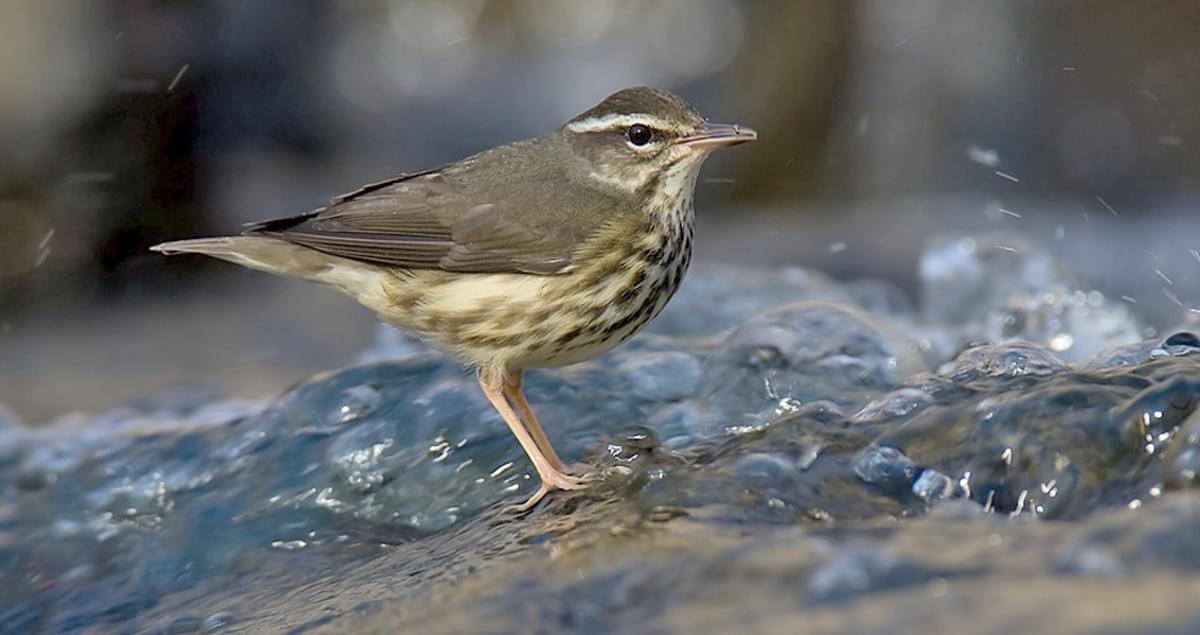Warblers are migratory songbirds that embark on long journeys, traveling from as far as Kansas to breeding grounds as distant as Canada. These vibrant and energetic birds make their way from their breeding to wintering grounds in a brilliant display of yellow and green, accompanied by a delightful medley of songs.
Wood-warblers, commonly known as North American warblers, primarily inhabit woodlands and forests. However, bird enthusiasts may experience a condition known as “warbler neck,” which entails a stiff and tingling sensation in the neck due to the act of gazing upward through binoculars in search of these elusive creatures among the trees.
While warblers predominantly feed on insects, they occasionally visit backyard feeders to partake in seeds or mealworms. For those interested in identifying other bird species that frequently visit Kansas, a complimentary identification chart can be obtained.
This comprehensive guide aims to assist individuals in identifying regularly occurring warbler species spotted in Kansas. It relies on data gathered from bird watchers on ebird, as well as information sourced from avibase, to provide accurate details about when these birds can be observed.
Warblers in Kansas during the summer include the Yellow Warbler, Northern Parula, Common Yellowthroat, Louisiana Waterthrush, Prothonotary Warbler, Kentucky Warbler, Yellow-breasted Chat, Yellow-throated Warbler, and Worm-eating Warbler.
Yellow-rumped Warblers and Pine Warblers are present in Kansas during the winter months.
When it comes to migration periods, Kansas becomes a temporary haven for Orange-crowned Warblers, Nashville Warblers, American Redstarts, Black-and-white Warblers, Tennessee Warblers, Wilson’s Warblers, Blackpoll Warblers, Chestnut-sided Warblers, Magnolia Warblers, Northern Waterthrushes, Palm Warblers, Ovenbirds, Mourning Warblers, Black-throated Green Warblers, Blackburnian Warblers, Golden-winged Warblers, Canada Warblers, Bay-breasted Warblers, Blue-winged Warblers, MacGillivray’s Warblers, Cape May Warblers, Hooded Warblers, Prairie Warblers, Black-throated Blue Warblers, Townsend’s Warblers, Cerulean Warblers, Black-throated Gray Warblers, and Virginia’s Warblers.
What Do Warblers Sound Like?
The melodic sounds of warblers often reach our ears before we catch sight of them. Familiarizing oneself with a few of their songs can greatly aid in identifying the bird in question. Fortunately, some warbler songs possess distinctive qualities that set them apart.
Warbler songs can be described as buzzy, clear, or trilling. They may rise or fall in pitch, encompassing a myriad of delightful notes. A buzzy note resembles the sound of an insect, while a clear note resonates like a whistle. Trills, on the other hand, are rapid and seamless, making it impossible to discern individual notes.
To familiarize oneself with warbler songs, one can refer to a guide that presents 13 easily recognizable warbler songs.
Warblers with Buzzy songs:
- The song of Black-throated Blue Warblers ascends and carries a distinctive buzz.
- Prairie Warblers also produce buzzy songs that ascend.
- Black-throated Green Warblers emit buzzy songs, with a couple of clear notes interspersed in the middle.
- Blackpoll Warblers’ songs are clear and steady, resembling the buzz of an insect.
- Prairie Warblers’ songs are buzzy and rise in pitch.
- Palm Warblers’ songs possess a buzzy quality.
Warblers with songs featuring clear notes:
- The song of Common Yellowthroats consists of a series of rising and falling notes that are repeated.
- Ovenbirds produce a series of rising and falling notes.
- Hooded Warblers also emit clear notes.
- Chestnut-sided Warblers’ songs consist of a series of clear falling notes that accelerate towards the end.
- Yellow-rumped Warblers produce a series of clear notes that gradually fade out.
- The song of Yellow Warblers gradually increases in speed.
- Northern Parulas showcase a rising trill that concludes with a distinct note, reminiscent of a punctuation mark.
- Wilson’s Warblers’ songs consist of a series of clear falling notes that quicken in pace.
Kansas is home to a total of 39 warbler species, including:
1. Yellow-rumped Warbler
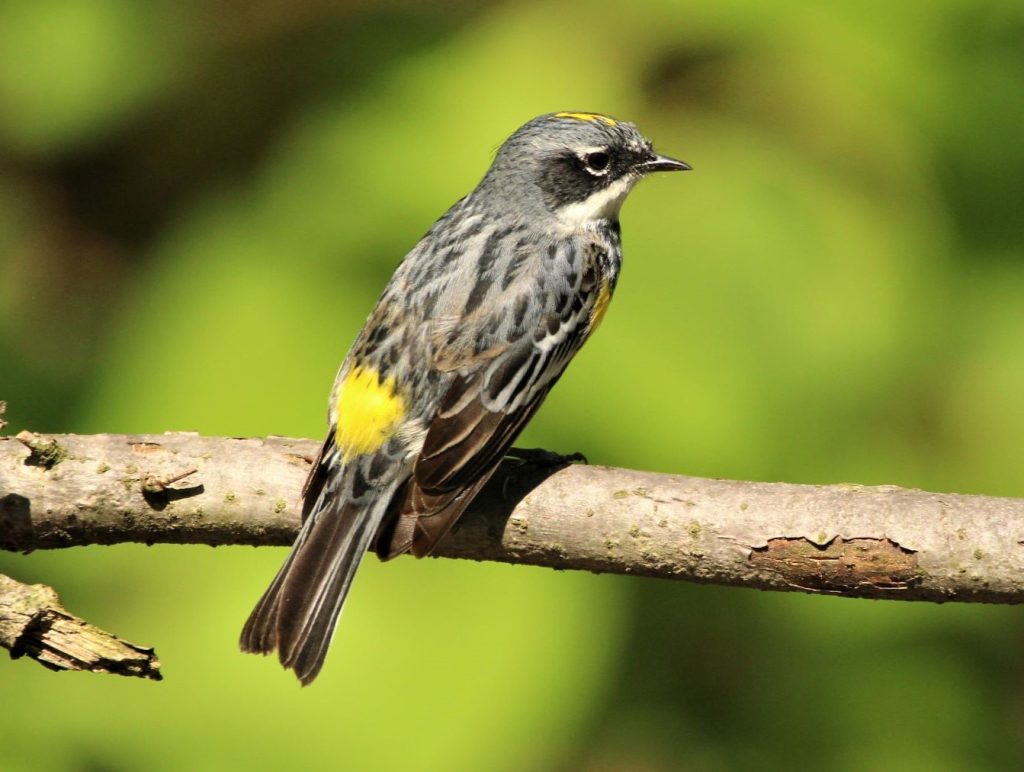
Yellow-rumped Warblers are commonly sighted in Kansas during the winter, with their numbers peaking during the spring and fall migrations. Approximately 10% of winter checklists and up to 33% of checklists during migration record their presence.
These warblers exhibit a gray coloration, adorned with splashes of yellow on their faces, sides, and rumps, as well as white wings. Females may display a slight brownish hue, while winter birds sport paler brown feathers, with their rumps and sides transitioning into vibrant yellow and gray during spring.
The species comprises two subspecies: the Myrtle Warbler, found in the eastern US and boreal forests of Canada, lacking a yellow throat, and the Audubon’s Warbler, prevalent in the western regions and featuring more extensive white wing patches.
Scientific name: Setophaga coronata
Length: 4.7-5.5 inches (12-14 cm)
Weight: 0.4-0.5 ounces (12-13 g)
Wingspan: 7.5-9.1 inches (19-23 cm)
Yellow-rumped Warblers primarily breed in Canada, as well as parts of the Rockies and the Appalachian mountains. During migration, they traverse the Midwest before seeking refuge in the southern and southwestern states of the US, along with the Pacific Coast, Mexico, and Central America.
Coniferous forests serve as the primary habitat for Yellow-rumped Warblers during the breeding season. In winter, they frequent open areas with fruit-bearing shrubs. Their diet primarily consists of insects during summer and transitions to a fruit-based diet during migration and winter, with favorites including bayberry and wax myrtle.
Yellow-rumped Warbler Song:
Credit: Christopher McPherson, XC602699. Accessible at www.xeno-canto.org/602699.
Yellow-rumped Warblers construct nests in conifer trees, carefully weaving twigs, pine needles, and grass while lining the interior with soft grass, moss, and hair. They lay up to six eggs, which incubate for approximately two weeks before the young fledge the nest after an additional two weeks.
To attract Yellow-rumped Warblers to one’s backyard, providing a variety of food sources such as sunflower seeds, suet, raisins, and peanut butter can prove enticing.
Fun Fact: During winter, Yellow-rumped Warblers form massive flocks numbering in the thousands, exhibiting aggression towards any other species that dares to encroach upon their space.
2. Yellow Warbler
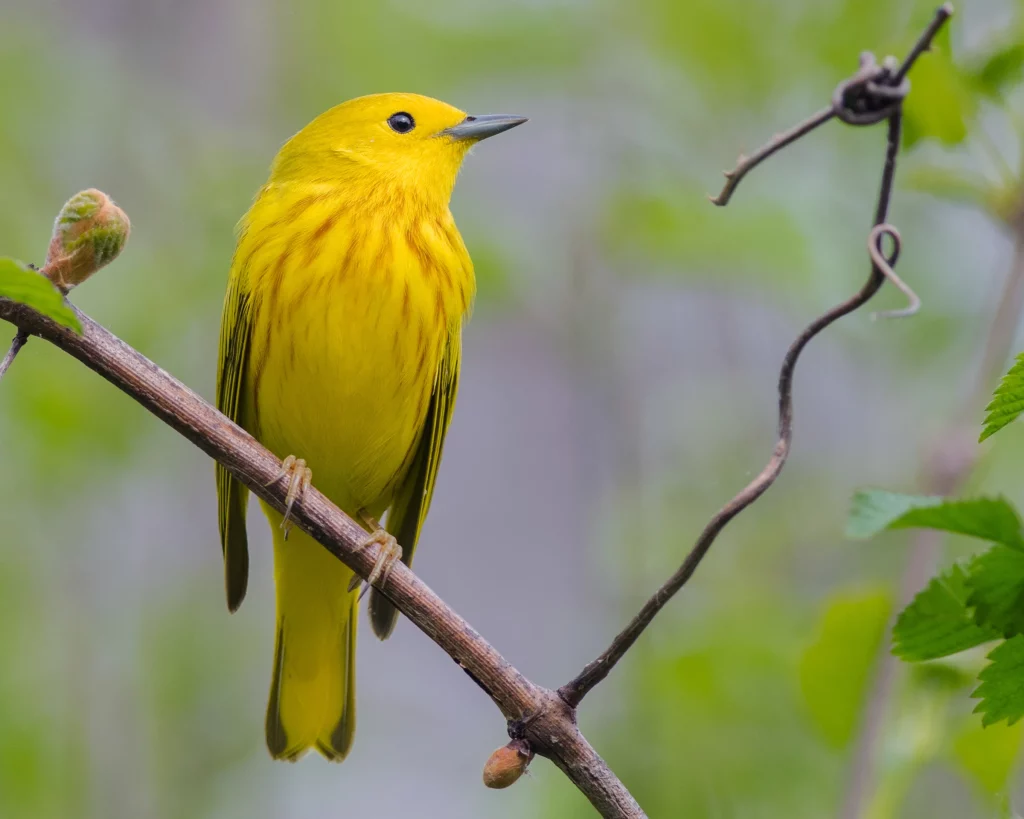
Yellow Warblers primarily grace Kansas during their breeding season, although they are most abundant during the spring migration in May. They appear on approximately 18% of summer checklists and up to 42% of checklists during spring migration.
These small, vibrant yellow birds boast a yellow-green back. Male Yellow Warblers sport chestnut streaks on their breasts, while females and juveniles possess a less vibrant coloration and lack the distinctive streaks.
Scientific name: Setophaga petechia
Length: 4.7-5.1 inches (12-13 cm)
Weight: 0.3-0.4 ounces (9-11 g)
Wingspan: 6.3-7.9 inches (16-20 cm)
Yellow Warblers undertake lengthy migrations, traveling from their breeding grounds in Canada and the US (excluding southeastern states) to Central and South America for the winter. However, they can be observed during migration in southeastern states of the US.
These delightful birds can be found near streams, wetlands, and thickets, often foraging for insects such as caterpillars, midges, beetles, bugs, and wasps.
Yellow Warbler Song:
Credit: Richard E. Webster, XC662546. Accessible at www.xeno-canto.org/662546.
Yellow Warbler nests are typically constructed in small trees or shrubs, expertly woven from bark, grass, and plant materials before being reinforced with spider webs to form a cup-shaped structure. The interior is then lined with softer materials like hair, feathers, and plant down. The females lay up to seven eggs, which incubate for approximately twelve days before the young depart the nest after an additional ten days.
To attract Yellow Warblers to backyard environments, offering suet, oranges, peanut butter, and plants that bear berries can entice these avian visitors. Additionally, planting native flora that attracts insects without the use of pesticides and maintaining a less meticulously groomed outdoor space can further enhance the appeal. Bird baths with fountains placed near secluded plantings provide added protection and attraction.
Fun Fact: Yellow Warblers often fall victim to brood parasitism by cowbirds. When detecting such intrusion, the Yellow Warblers respond by building a new nest on top of the old one, restarting the process multiple times – up to six occasions!
3. Northern Parula
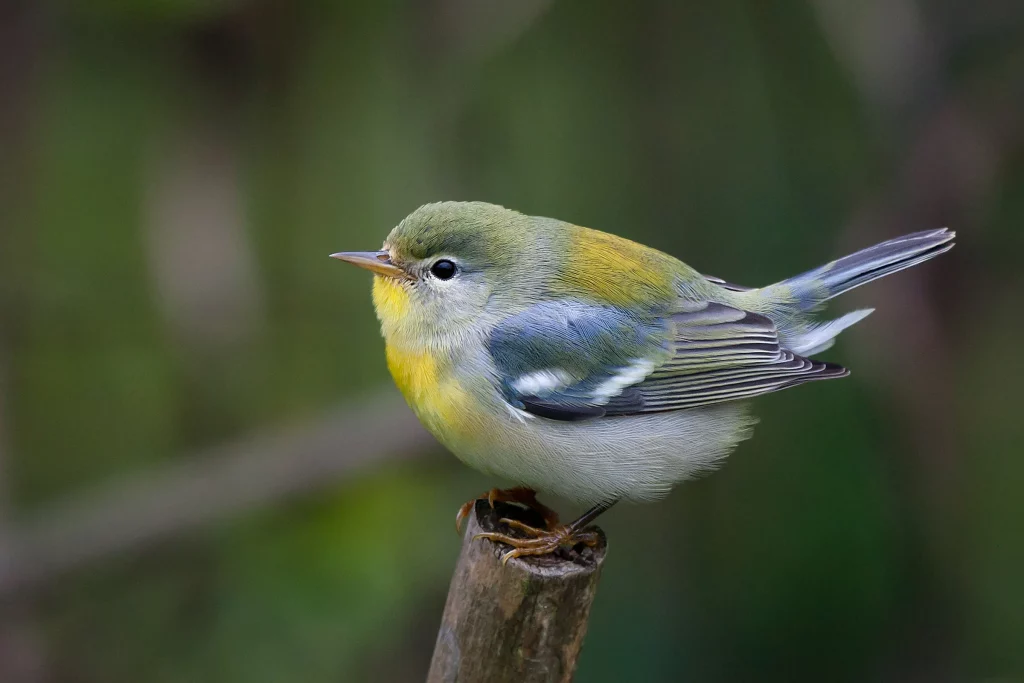
Northern Parulas spend their summers in Kansas and are predominantly observed in the eastern region of the state from April to October. They feature on approximately 11% of summer checklists.
These warblers exhibit a vibrant contrast of blueish-gray and yellow. Their backs are bluish-gray, adorned with a yellow patch, and they boast two white wingbars. Both males and females display a chestnut band that separates the yellow throat and chest. Females possess a paler appearance compared to males, lacking the chestnut band, while juveniles are even paler.
Scientific name: Setophaga americana
Length: 4.3-4.7 inches (11-12 cm)
Weight: 0.2-0.4 ounces (5-11 g)
Wingspan: 6.3-7.1 inches (16-18 cm)
Northern Parulas breed in eastern US states and southeastern Canada before embarking on their journey to Central America and the Caribbean for winter. Some individuals may choose to remain in southern Florida for the winter.
These warblers can be found foraging on insects high up in deciduous forests.
Northern Parula Song:
Credit: Christopher McPherson, XC599828. Accessible at www.xeno-canto.org/599828.
Nests of Northern Parulas are concealed among large clumps of hanging moss, expertly constructed from lichen and moss. Spotting them often involves gazing upwards at these majestic clumps during the summer months.
Attracting Northern Parulas to backyard spaces can be achieved by incorporating native trees and shrubs, particularly those that bear berries. Additionally, leaving brush piles to create insect-friendly areas contributes to their appeal.
Fun Fact: Northern Parula females handle the rearing of their young, including incubation and feeding, while males focus on singing and removing fecal sacs!
4. Common Yellowthroat
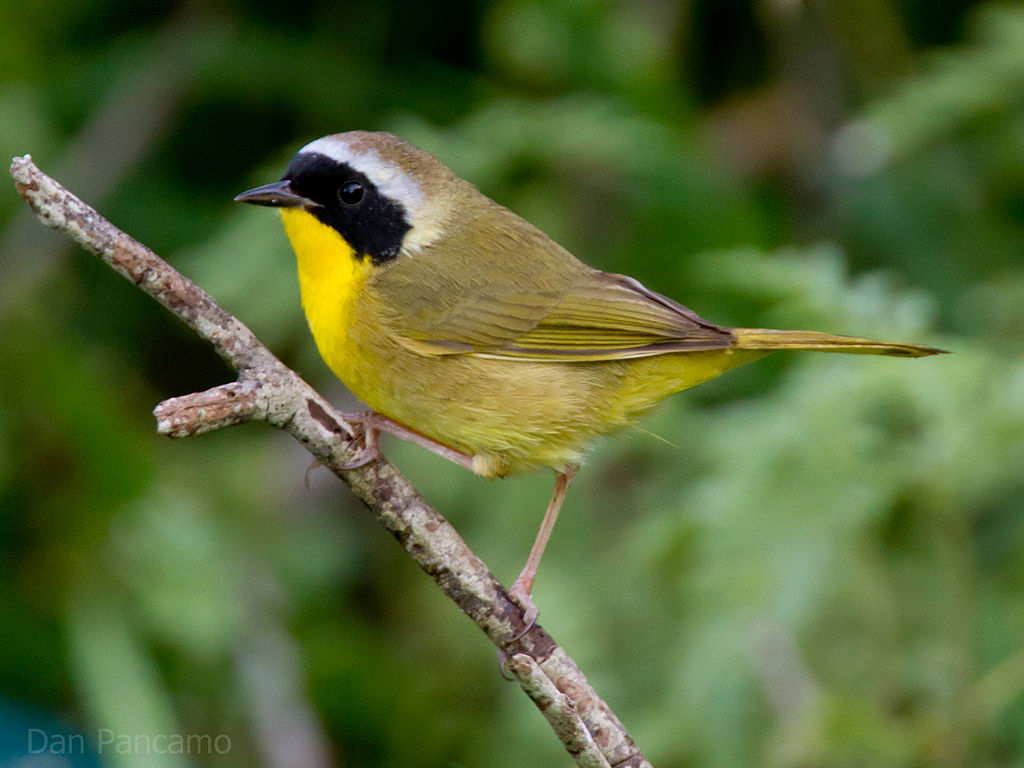
Common Yellowthroats are frequently spotted during the breeding season in Kansas, particularly from mid-April to October. They make
appearances on approximately 13% of summer checklists.
These small songbirds possess brownish-colored backs and vibrant yellow undersides, accompanied by long tails. Males exhibit a distinctive black mask across their faces. The intensity of the yellow plumage may vary geographically, and individuals in certain regions may display a more olive hue beneath.
Scientific name: Geothlypis trichas
Length: 4.3-5.1 inches (11-13 cm)
Weight: 0.3-0.3 ounces (9-10 g)
Wingspan: 5.9-7.5 inches (15-19 cm)
Common Yellowthroats breed across most of North America, excluding Alaska and northern Canada. Some populations remain in Gulf Coast and Pacific Southwest regions throughout the year, while others migrate south for the winter.
These charming birds are commonly found in marshy or wetland areas and brushy fields, where they take shelter amidst thick, tangled vegetation.
Common Yellowthroat Song:
Credit: Paul Marvin, XC629250. Accessible at www.xeno-canto.org/629250.
Nests of Common Yellowthroats are constructed by females near the ground in marshy areas, utilizing reeds for support. The nests are woven from grass, sedges, and other plant materials, forming a platform of leaves and grass. The interior is then lined with softer materials like moss, hair, and feathers. They lay up to six eggs, requiring around twelve days for hatching, followed by an additional ten days for the young to fledge.
To attract Common Yellowthroats to larger backyards, dense vegetation and native plants can be incorporated, especially those that bear berries. Creating brush piles also fosters insect-friendly environments.
Fun Fact: The black mask displayed by male Common Yellowthroats serves as a signal to courting males, indicating their gender. Consequently, they exhibit aggression towards fake birds adorned with masks but remain indifferent when encountering mask-less counterparts.
5. Orange-crowned Warbler
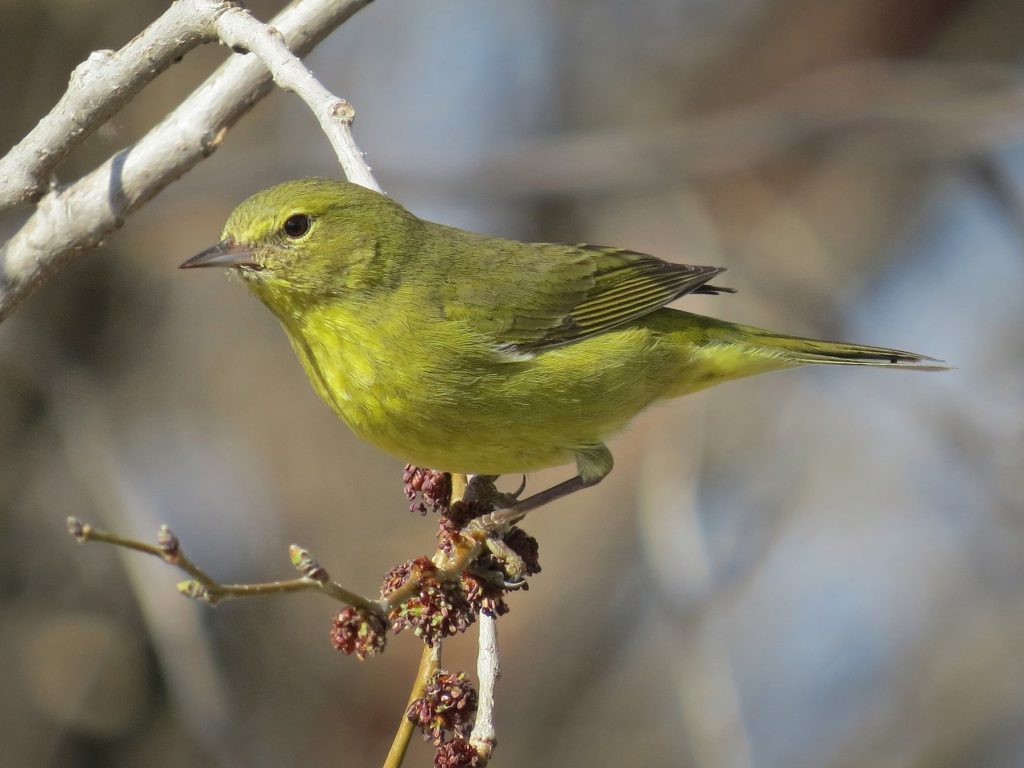
Orange-crowned Warblers can be spotted in Kansas during migration, specifically from April to May and September to October. They appear on approximately 18% of checklists during migration.
These warblers possess a less vibrant coloration compared to their counterparts, showcasing yellow-olive hues, which may appear more yellow along the Pacific Coast. Their orange crowns are seldom visible. Males and females exhibit similar appearances, while juveniles possess a grayer plumage.
Scientific name: Leiothlypis celata
Length: 4.3-5.5 inches (11-14 cm)
Weight: 0.3-0.4 ounces (7-11 g)
Wingspan: 7.5 inches (19 cm)
Orange-crowned Warblers breed in Canada, as well as western US states, before embarking on migrations to the Pacific, East, and Gulf Coasts, along with Mexico. They can also be observed during migration across most states of the US, excluding the northeastern region.
These warblers frequent shrubs and low-lying vegetation, with a preference for open woodlands during the breeding season. Their diet primarily consists of spiders and insects, including caterpillars and flies. Additionally, they occasionally consume fruits, berries, and seeds, and may visit backyard feeders.
Orange-crowned Warbler Song:
Credit: Paul Marvin, XC671865. Accessible at www.xeno-canto.org/671865.
Nests of Orange-crowned Warblers are located near or on the ground, constructed using dead leaves, twigs, and stems, and lined with soft grass and animal hair. They lay up to six eggs.
To attract Orange-crowned Warblers to backyard spaces, offering suet and peanut butter, as well as providing hummingbird feeders filled with sugar water nectar, can prove enticing.
Fun Fact: Orange-crowned Warblers often indulge in drinking sap from the wells created by sapsuckers and woodpeckers.
6. Nashville Warbler
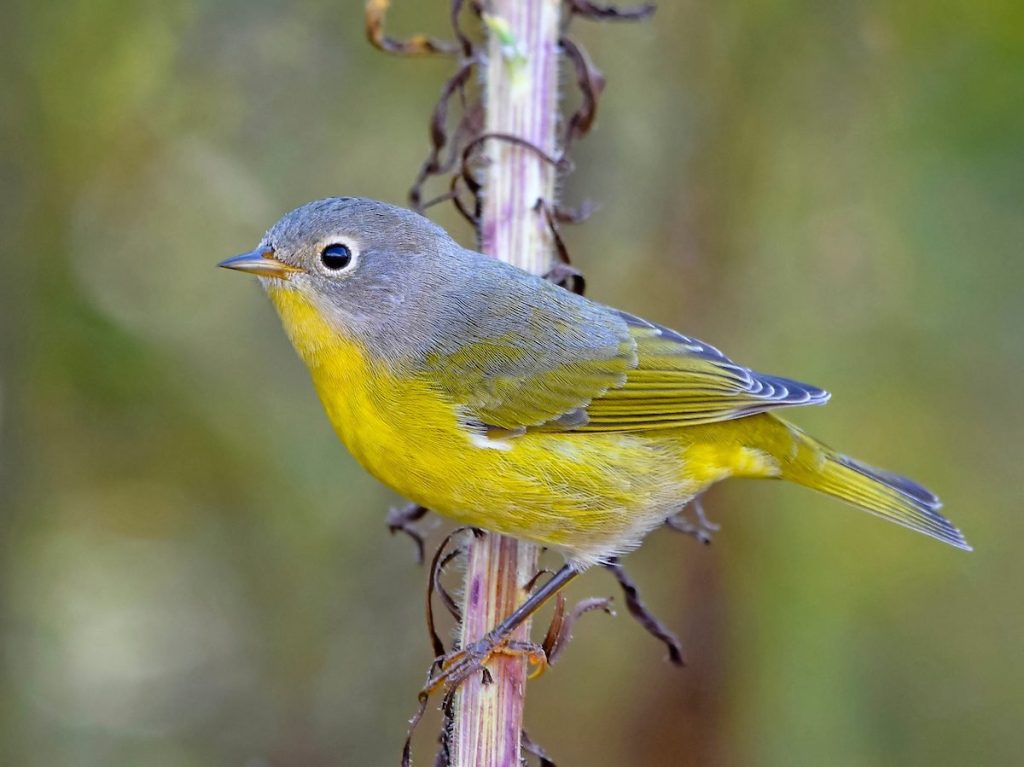
Nashville Warblers make appearances in Kansas during the spring and fall migrations, specifically from April to May and August to November.
These warblers exhibit predominantly yellow plumage, complemented by a green back and a gray head adorned with a white eye-ring. Females possess a greener hue with yellow undersides and green heads. Both genders showcase white bellies between their yellow breasts and under their tails.
Scientific name: Leiothlypis ruficapilla
Length: 4.3-5.1 inches (11-13 cm)
Weight: 0.2-0.5 ounces (6.7-13.9 g)
Wingspan: 6.7-7.9 inches (17-20 cm)
Nashville Warblers breed in northeastern US states and Canada, with a smaller population residing in northwestern US states and British Columbia. They can also be observed during migration across most states.
These warblers are often found in scrubby habitats and low deciduous forests, where they hunt for insects.
Nashville Warbler Song:
Credit: Peter Ward and Ken Hall, XC512262. Accessible at www.xeno-canto.org/512262.
Nests of Nashville Warblers are situated close to the ground, often hidden under logs or shrubs. Constructed from bark, moss, and grass, the nests are woven into a cup shape and lined with pine needles, soft grass, and animal hair. They lay around five eggs, with an incubation period of approximately twelve days, followed by an additional ten days for the young to fledge.
To attract Nashville Warblers to backyard environments in winter, placing suet feeders in southern US states can be effective.
Fun Fact: During their first migration, Nashville Warblers follow the Atlantic Coast. However, subsequent migrations typically take an inland route.
7. Louisiana Waterthrush
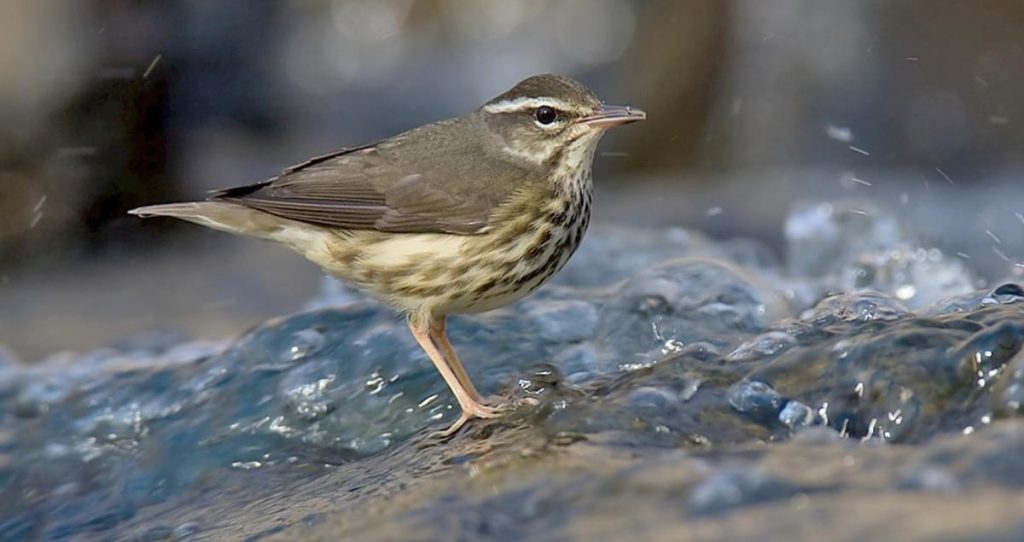
Louisiana Waterthrushes can be found in eastern Kansas during the summer, from mid-March to September. They feature on approximately 4% of checklists during this period.
Compared to other warblers, Louisiana Waterthrushes may appear less vibrant in terms of coloration. They sport brown plumage on their backs and pale undersides. These birds boast white eyebrow stripes and long, pink legs.
Scientific name: Parkesia motacilla
Length: 5.9-6.1 inches (15-15.5 cm)
Weight: 0.6-0.8 ounces (18.2-22.9 g)
Wingspan: 9.4-10.6 inches (24-27 cm)
Louisiana Waterthrushes breed in eastern US states, occasionally observed during migration in the southeast. They spend their winter months in Mexico, Central America, and the Caribbean, returning to their breeding grounds early in the year.
These waterthrushes can be found along streams and moving water within woodlands, where they forage for insects, vertebrates, and larvae.
Louisiana Waterthrush Song:
Credit: Christopher McPherson, XC691609. Accessible at www.xeno-canto.org/691609.
Nests of Louisiana Waterthrushes are located along stream banks, often concealed within roots or under logs. Constructed from leaves, pine needles, and other plant material, the nests are held together with mud. They lay up to six eggs, requiring two weeks for hatching.
Fun Fact: Distinguishing Louisiana Waterthrushes from Northern Waterthrushes can be accomplished by noting the former’s larger bill and preference for running water, while the latter favors still water.
8. American Redstart

American Redstarts spend the breeding season in Kansas, although they are more commonly observed during migration in May and September.
These warblers exhibit mostly black plumage, adorned with bright orange patches and a white belly. Females possess olive-gray coloring instead of black, featuring yellow patches.
Scientific name: Setophaga ruticilla
Length: 4.3-5.1 inches (11-13 cm)
Weight: 0.2-0.3 ounces (6-9 g)
Wingspan: 6.3-7.5 inches (16-19 cm)
American Redstarts breed in eastern US states and Canada, extending into northwestern US states. They can be observed during migration across central and western US states.
These warblers can be found in deciduous woodlands, where they actively hunt for insects. Additionally, they may visit backyards and thickets in search of berries such as serviceberry and magnolia.
American Redstart Song: Their song features a drop in pitch towards the end.
Credit: Nick Kiehl, XC522368. Accessible at www.xeno-canto.org/522368.
Nests of American Redstarts are typically situated close to the trunk of trees or large shrubs. Constructed from bark, grass, and other plant materials, the nests provide a secure environment for their young. They lay up to five eggs, requiring approximately two weeks for hatching, followed by a week or two for the young to fledge.
To attract American Redstarts to backyard spaces, incorporating berry plants like magnolia and serviceberry can prove enticing.
Fun Fact: American Redstart parents selectively feed specific chicks rather than providing food to all individuals.
9. Black-and-white Warbler
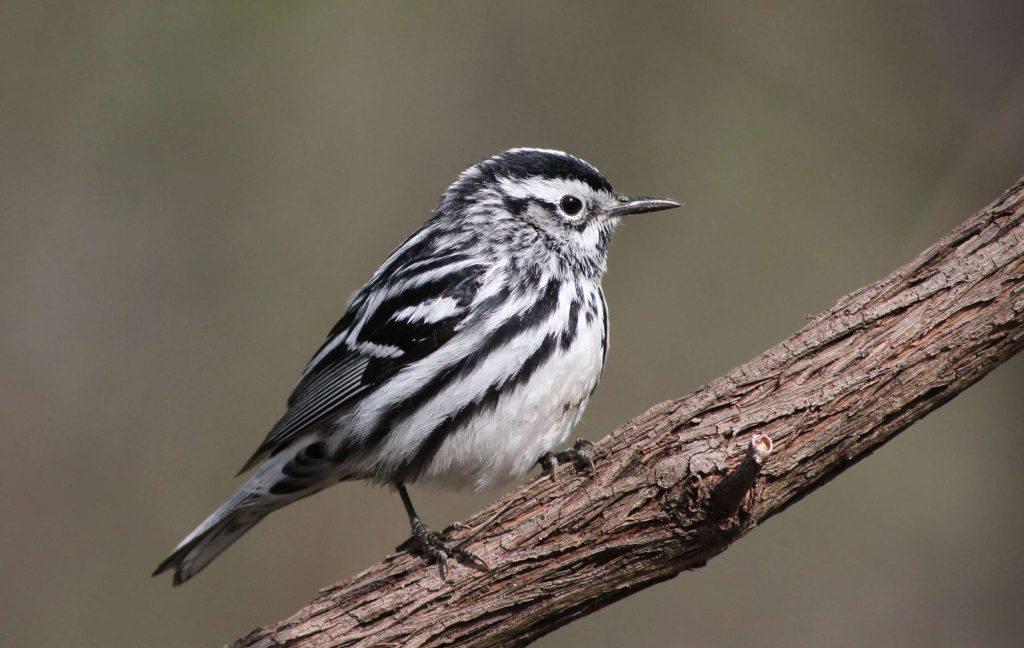
Black-and-white Warblers are often observed during migration in Kansas, although some individuals spend the breeding season in the eastern part of the state. They can be found on approximately 4% of summer checklists and up to 10% of checklists during spring migration.
These warblers showcase a distinct striped appearance, making them relatively easy to identify. Males display a sizable black patch across the eye and cheek, boasting a darker black coloration compared to females.
Scientific name: Mniotilta varia
Length: 4.3-5.1 inches (11-13 cm)
Weight: 0.3-0.5 ounces (8-15 g)
Wingspan: 7.1-8.7 inches (18-22 cm)
Black-and-white Warblers breed in the eastern United States and Canada. During winter, they migrate to regions such as Florida, the Gulf Coast, Mexico, Baja California, the Caribbean, and northern South America. They can be observed during migration across central US states.
These warblers are often spotted hopping up and down tree trunks and branches in forests, diligently searching for insects.
Black-and-white Warbler Song:
Credit: Christopher McPherson, XC600300. Accessible at www.xeno-canto.org/600300.
Nests of Black-and-white Warblers are hidden close to or on the ground, frequently beneath logs or shrubs. Constructed from bark, grass, and pine needles, the nests are woven into a cup shape. They lay approximately five eggs, requiring around eleven days for hatching, followed by an additional ten days for the young to fledge.
10. Tennessee Warbler
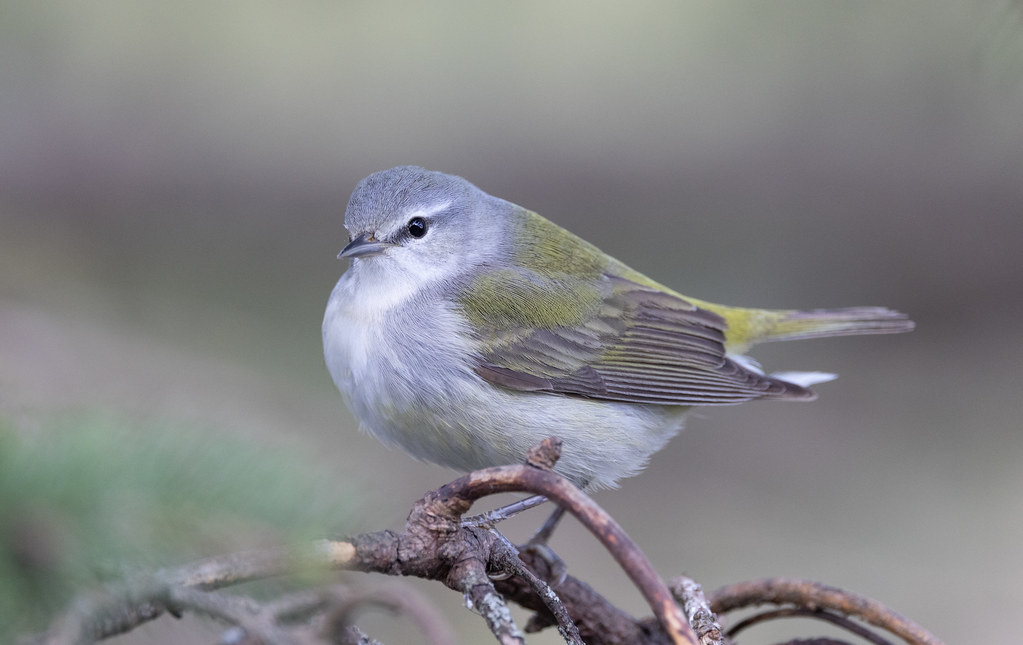
Tennessee Warblers are encountered in Kansas during migration, particularly from mid-April to May and September to October. They feature on around 14% of checklists during spring migration and 1% of checklists during fall migration.
Male Tennessee Warblers possess gray heads, green backs, and pale whitish undersides. Females exhibit greener hues with yellow undersides and green heads. Males sport a white eyestripe, while females showcase a yellow eyestripe. Both genders boast white undertail coverts.
Scientific name: Leiothlypis peregrina
Length: 3.9-5.1 inches (10-13 cm)
Weight: 0.3-0.3 ounces (8-10 g)
Wingspan: 7.5-7.9 inches (19-20 cm)
Tennessee Warblers undertake a lengthy migration, traveling from Central America to Canada. They can be observed during migration across eastern US states.
These warblers are often found feeding on trees and shrubs in woodlands, primarily targeting caterpillars.
Tennessee Warbler Song:
Credit: Christopher McPherson, XC444969. Accessible at www.xeno-canto.org/444969.
Nests of Tennessee Warblers are hidden within moss or tree roots, constructed from grass and weeds. They lay approximately six eggs, requiring about twelve days for hatching.
Fun Fact: Despite their name, Tennessee Warblers do not breed or spend significant time in Tennessee. They were named after the location where they were initially sighted and subsequently given this moniker.
11. Wilson’s Warbler
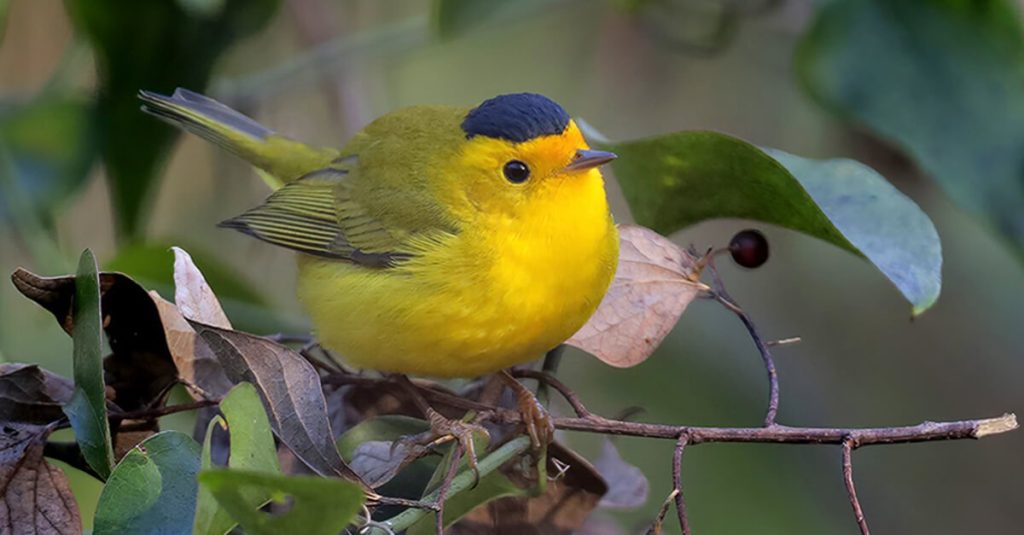
Wilson’s Warblers can be spotted in Kansas during migration from mid-April to May and again from August to September. They are recorded on approximately 8% of checklists during spring migration and 5% of checklists during fall migration.
These warblers exhibit bright yellow plumage with a distinctive black cap on the head. They have olive-green backs, and females may display a slightly duller coloration.
Scientific name: Cardellina pusilla
Length: 4.7-5.1 inches (12-13 cm)
Weight: 0.3-0.4 ounces (8-11 g)
Wingspan: 7.5 inches (19 cm)
Wilson’s Warblers breed in western US states, Canada, and Alaska. They can be observed during migration across most US states.
These warblers are often found in thickets, shrubby areas, and willow or alder thickets near water bodies. They feed on insects, spiders, and occasionally small berries.
Wilson’s Warbler Song:
Credit: Greg Irving, XC643553. Accessible at www.xeno-canto.org/643553.
Nests of Wilson’s Warblers are built on the ground or in low shrubs, constructed from grass, bark, leaves, and moss, lined with fine grasses and hair. They lay approximately five eggs, requiring about two weeks for hatching.
12. Blackpoll Warbler

Blackpoll Warblers pass through Kansas during migration, particularly from late April to May and again from late August to September. They are recorded on approximately 8% of checklists during spring migration and 6% of checklists during fall migration.
These warblers exhibit black and white plumage. Males display a black cap and white cheeks, while females possess more grayish tones.
Scientific name: Setophaga striata
Length: 4.7-5.1 inches (12-13 cm)
Weight: 0.4-0.5 ounces (12-13 g)
Wingspan: 7.5-8.7 inches (19-22 cm)
Blackpoll Warblers breed in boreal forests across northern Canada and Alaska. During migration, they can be observed across the entire United States.
These warblers primarily feed on insects, including caterpillars, spiders, and beetles. They may also consume small berries and fruits.
Blackpoll Warbler Song:
Credit: Richard E. Webster, XC682242. Accessible at www.xeno-canto.org/682242.
Nests of Blackpoll Warblers are built in coniferous trees, constructed from twigs, grasses, and moss, lined with hair and feathers. They lay approximately four to five eggs, requiring about two weeks for hatching.
13. Chestnut-sided Warbler
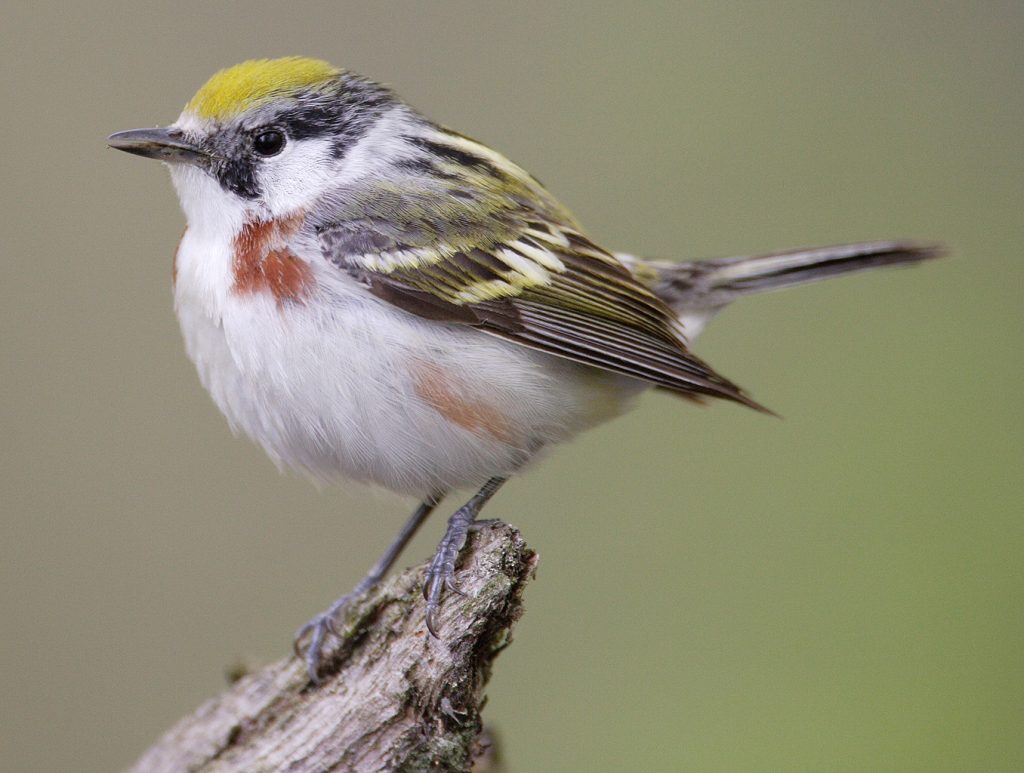
Chestnut-sided Warblers pass through Kansas during migration, particularly from late April to May and again from late August to September. They are recorded on approximately 10% of checklists during spring migration and 7% of checklists during fall migration.
These warblers exhibit vibrant plumage with a chestnut-colored crown, white undersides, and yellow flanks. Males have distinctive chestnut streaks on their sides, while females display a duller coloration.
Scientific name: Setophaga pensylvanica
Length: 4.7-5.1 inches (12-13 cm)
Weight: 0.4-0.5 ounces (11-14 g)
Wingspan: 7.5-8.7 inches (19-22 cm)
Chestnut-sided Warblers breed in eastern US states and parts of Canada. During migration, they can be observed across most US states.
These warblers prefer habitats with dense shrubs, young forests, and regenerating clearings. They feed on insects, including caterpillars, beetles, and spiders.
Chestnut-sided Warbler Song:
Credit: Andrew Simon, XC686964. Accessible at www.xeno-canto.org/686964.
Nests of Chestnut-sided Warblers are built in low vegetation, often within shrubs or small trees, constructed from grass, bark, twigs, and plant fibers, lined with finer materials such as hair and feathers. They lay approximately three to five eggs, requiring about two weeks for hatching.
14. Magnolia Warbler
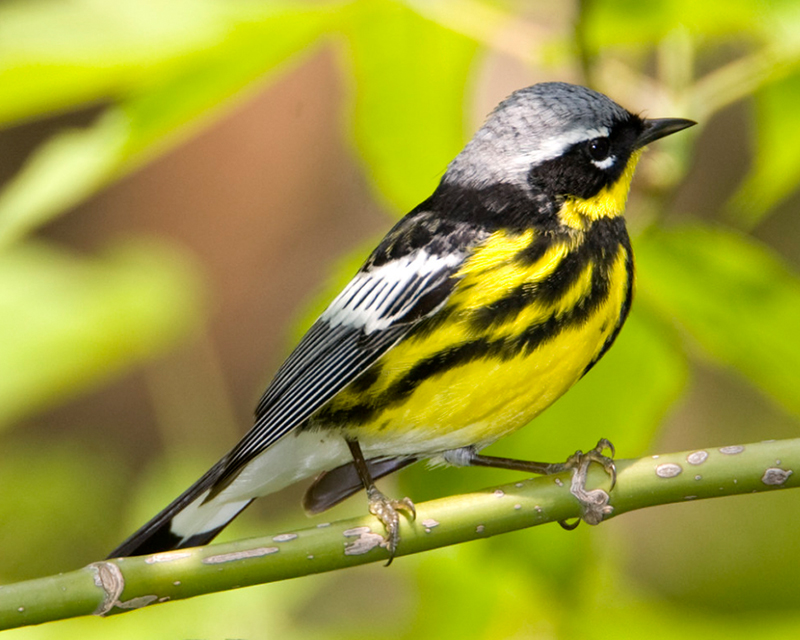
Magnolia Warblers pass through Kansas during migration, particularly from late April to May and again from late August to September. They are recorded on approximately 12% of checklists during spring migration and 8% of checklists during fall migration.
These warblers exhibit black and yellow plumage. Males possess a black necklace-like band across the yellow breast, while females display duller colors.
Scientific name: Setophaga magnolia
Length: 4.7-5.1 inches (12-13 cm)
Weight: 0.3-0.4 ounces (9-11 g)
Wingspan: 7.1-8.7 inches (18-22 cm)
Magnolia Warblers breed in boreal forests across Canada and Alaska. During migration, they can be observed across the entire United States.
These warblers primarily feed on insects, including caterpillars, spiders, and beetles. They may also consume small berries and fruits.
Magnolia Warbler Song:
Credit: Richard E. Webster, XC683918. Accessible at www.xeno-canto.org/683918.
Nests of Magnolia Warblers are built on or near the ground, often hidden in dense vegetation, constructed from grass, bark, twigs, and moss, lined with softer materials such as hair and feathers. They lay approximately four to five eggs, requiring about two weeks for hatching.
15. Northern Waterthrush
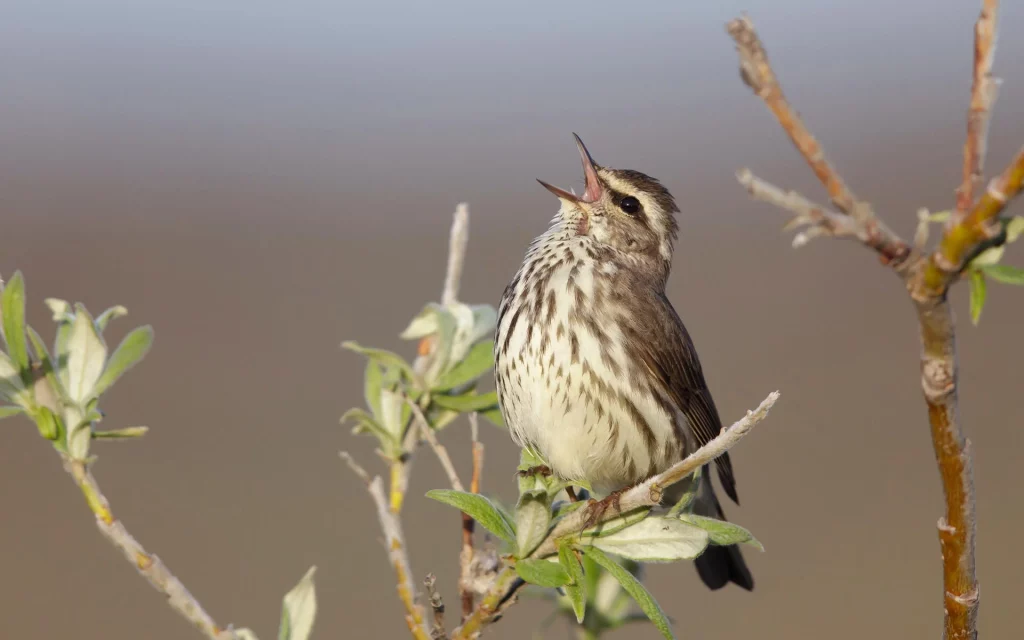
Northern Waterthrushes pass through Kansas during migration, particularly from late April to May and again from late August to September. They are recorded on approximately 9% of checklists during spring migration and 5% of checklists during fall migration.
These warblers exhibit brownish plumage with streaks on the breast and flanks. They have a distinctive white eyebrow stripe and pink legs.
Scientific name: Parkesia noveboracensis
Length: 4.7-5.5 inches (12-14 cm)
Weight: 0.4-0.6 ounces (12-17 g)
Wingspan: 7.5-8.7 inches (19-22 cm)
Northern Waterthrushes breed in boreal forests across northern North America. During migration, they can be observed across the entire United States.
These warblers prefer habitats near water bodies, such as swamps, marshes, and wetlands. They feed on insects, spiders, and small crustaceans.
Northern Waterthrush Song:
Credit: Tim Spahr, XC560551. Accessible at www.xeno-canto.org/560551.
Nests of Northern Waterthrushes are built on the ground near water, often hidden under vegetation or tree roots. They are constructed from grass, leaves, and moss, lined with fine grasses, feathers, and hair. They lay approximately four to six eggs, requiring about two weeks for hatching.
16. Palm Warbler
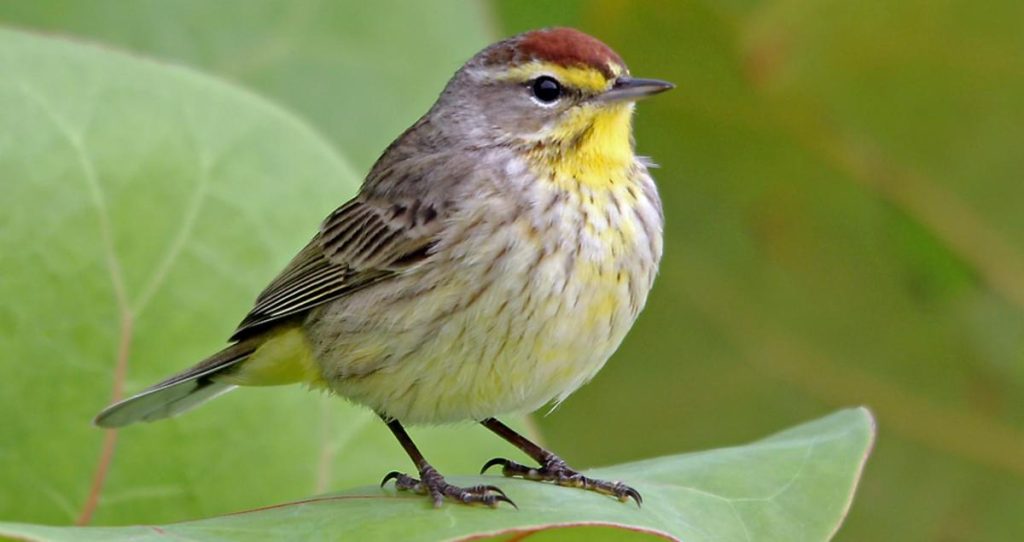
Palm Warblers pass through Kansas during migration, particularly from late April to May and again from late August to September. They are recorded on approximately 10% of checklists during spring migration and 6% of checklists during fall migration.
These warblers exhibit brownish plumage with a rusty cap and yellow undertail coverts. They often wag their tails, a behavior that aids in identification.
Scientific name: Setophaga palmarum
Length: 4.7-5.1 inches (12-13 cm)
Weight: 0.3-0.4 ounces (9-11 g)
Wingspan: 7.1-7.9 inches (18-20 cm)
Palm Warblers breed in northern North America, including Canada and Alaska. During migration, they can be observed across the entire United States.
These warblers prefer open habitats such as bogs, marshes, and fields with scattered trees. They feed on insects, spiders, and small seeds.
Palm Warbler Song:
Credit: Andrew Spencer, XC338413. Accessible at www.xeno-canto.org/338413.
Nests of Palm Warblers are built on or near the ground, often hidden under shrubs or grasses. They are constructed from grass, moss, and plant fibers, lined with fine grasses and hair. They lay approximately four to five eggs, requiring about two weeks for hatching.
17. Ovenbird

Ovenbirds pass through Kansas during migration, particularly from late April to May and again from late August to September. They are recorded on approximately 8% of checklists during spring migration and 5% of checklists during fall migration.
These warblers exhibit brownish plumage with a distinctive orange crown stripe bordered by black lines. They have a rounded body and a habit of walking on the ground.
Scientific name: Seiurus aurocapilla
Length: 5.5-6.3 inches (14-16 cm)
Weight: 0.6-0.7 ounces (16-20 g)
Wingspan: 7.9-9.1 inches (20-23 cm)
Ovenbirds breed in eastern US states and parts of Canada. During migration, they can be observed across the entire United States.
These warblers prefer habitats with dense undergrowth, such as forests and thickets. They feed on insects, spiders, and other small invertebrates.
Ovenbird Song:
Credit: William Adsett, XC626535. Accessible at www.xeno-canto.org/626535.
Nests of Ovenbirds are built on the ground, resembling an old-fashioned outdoor oven, hence the name. They are constructed from leaves, grass, and bark, lined with fine grasses and hair. They lay approximately three to six eggs, requiring about two weeks for hatching.
18. Mourning Warbler

Mourning Warblers pass through Kansas during migration, particularly from late April to May and again from late August to September. They are recorded on approximately 5% of checklists during spring migration and 3% of checklists during fall migration.
These warblers exhibit olive-green plumage with a blue-gray hood and yellow undertail coverts. They have a distinctive eye-ring and a relatively short tail.
Scientific name: Geothlypis philadelphia
Length: 4.7-5.1 inches (12-13 cm)
Weight: 0.3-0.4 ounces (8-11 g)
Wingspan: 7.1-7.5 inches (18-19 cm)
Mourning Warblers breed in northeastern US states and parts of Canada. During migration, they can be observed across the entire United States.
These warblers prefer habitats with dense undergrowth, such as young forests, thickets, and shrubby areas. They feed on insects, spiders, and small fruits.
Mourning Warbler Song:
Credit: Dan Dugan, XC653109. Accessible at www.xeno-canto.org/653109.
Nests of Mourning Warblers are built on or near the ground, often hidden in dense vegetation. They are constructed from leaves, grass, and bark, lined with fine grasses and hair. They lay approximately four to five eggs, requiring about two weeks for hatching.
19. Black-throated Green Warbler
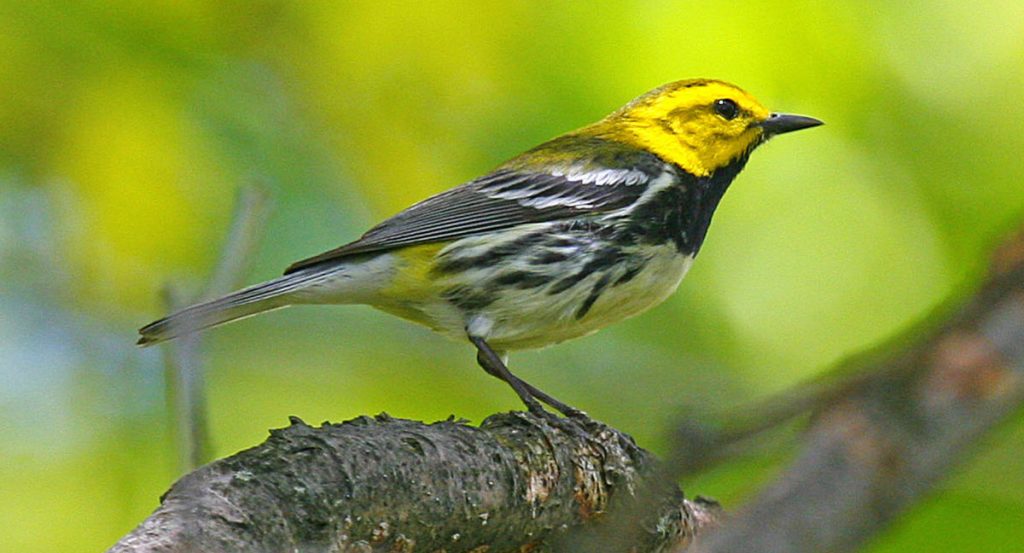
Black-throated Green Warblers pass through Kansas during migration, particularly from late April to May and again from late August to September. They are recorded on approximately 10% of checklists during spring migration and 6% of checklists during fall migration.
These warblers exhibit olive-green plumage with a black throat and face. Males possess a yellow face and black streaks on their sides, while females display duller colors.
Scientific name: Setophaga virens
Length: 4.7-5.1 inches (12-13 cm)
Weight: 0.3-0.4 ounces (9-11 g)
Wingspan: 7.1-7.9 inches (18-20 cm)
Black-throated Green Warblers breed in northeastern US states and parts of Canada. During migration, they can be observed across the entire United States.
These warblers prefer mature forests, particularly coniferous and mixed forests. They feed on insects, spiders, and occasionally small fruits.
Black-throated Green Warbler Song:
Credit: Andrew Spencer, XC465425. Accessible at www.xeno-canto.org/465425.
Nests of Black-throated Green Warblers are built on or near the ground, often hidden in dense vegetation or shrubs. They are constructed from bark, twigs, and grass, lined with fine grasses, feathers, and hair. They lay approximately four to five eggs, requiring about two weeks for hatching.
20. Blackburnian Warbler
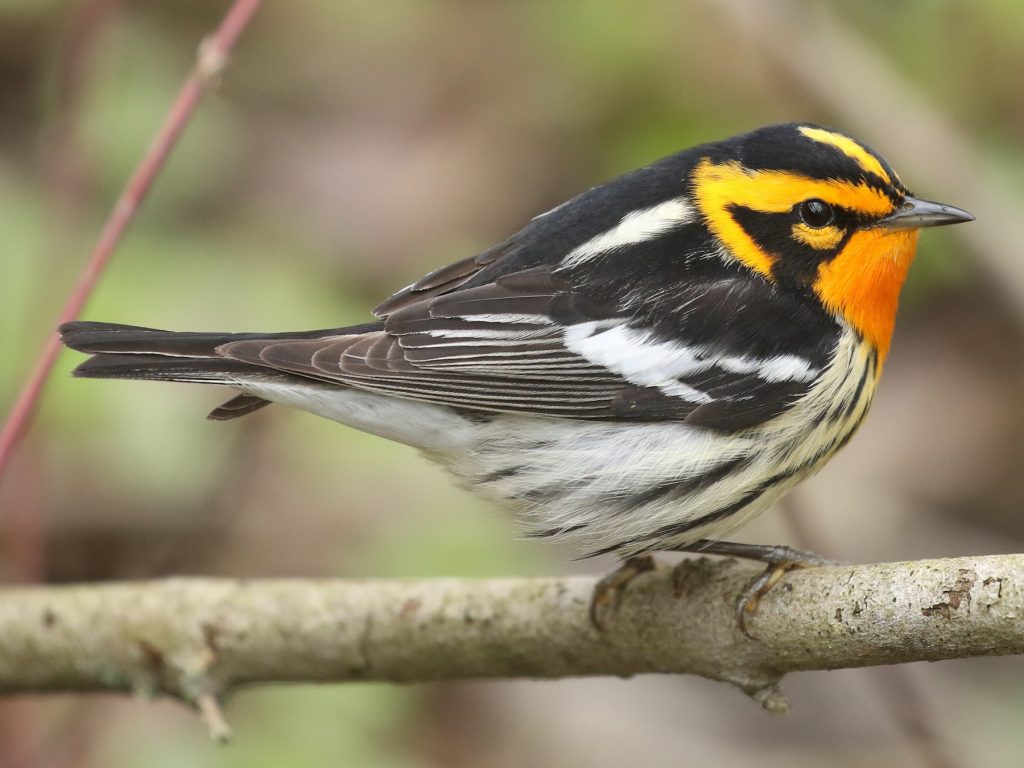
Blackburnian Warblers pass through Kansas during migration, particularly from late April to May and again from late August to September. They are recorded on approximately 6% of checklists during spring migration and 4% of checklists during fall migration.
These warblers exhibit vibrant orange plumage with a black crown and back. Males possess a flame-orange throat, while females display duller colors with a yellow throat.
Scientific name: Setophaga fusca
Length: 4.3-4.7 inches (11-12 cm)
Weight: 0.3-0.4 ounces (8-11 g)
Wingspan: 7.1-7.5 inches (18-19 cm)
Blackburnian Warblers breed in northeastern US states and parts of Canada. During migration, they can be observed across the entire United States.
These warblers prefer mature coniferous and mixed forests, particularly at higher elevations. They feed on insects, spiders, and occasionally small fruits.
Blackburnian Warbler Song:
Credit: Frank Lambert, XC643378. Accessible at www.xeno-canto.org/643378.
Nests of Blackburnian Warblers are built on or near the ground, often hidden in dense vegetation or shrubs. They are constructed from bark, twigs, and grass, lined with fine grasses, feathers, and hair. They lay approximately three to five eggs, requiring about two weeks for hatching.
21. Golden-winged Warbler
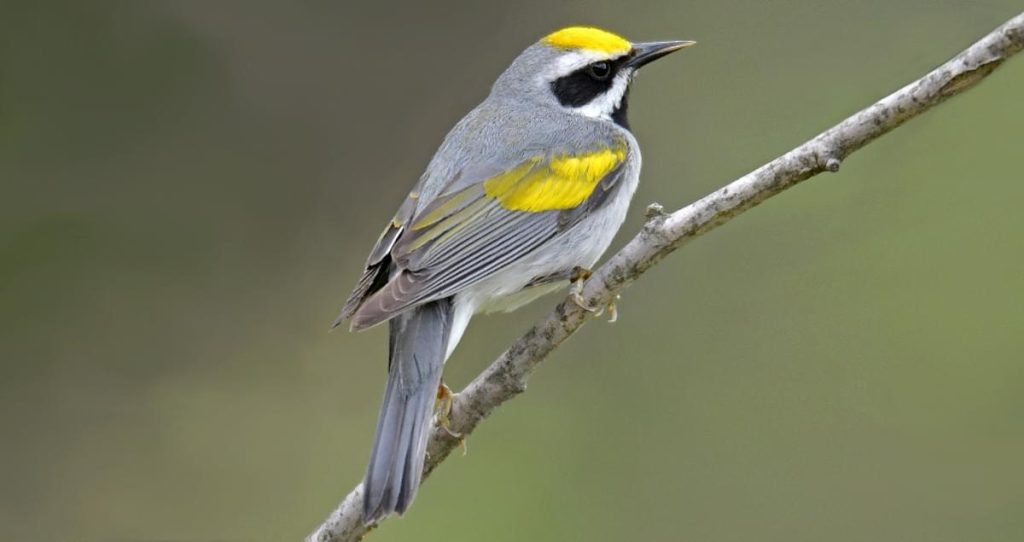
Golden-winged Warblers pass through Kansas during migration, particularly from late April to May and again from late August to September. They are recorded on approximately 4% of checklists during spring migration and 3% of checklists during fall migration.
These warblers exhibit grayish-blue plumage with white wing bars and a yellow crown patch. Males possess a black throat, while females display a gray throat.
Scientific name: Vermivora chrysoptera
Length: 4.3-4.7 inches (11-12 cm)
Weight: 0.3-0.4 ounces (9-11 g)
Wingspan: 7.5-7.9 inches (19-20 cm)
Golden-winged Warblers breed in northeastern US states and parts of Canada. During migration, they can be observed across the entire United States.
These warblers prefer early successional habitats, such as young forests, shrubby areas, and regenerating clearings. They feed on insects, spiders, and occasionally small fruits.
Golden-winged Warbler Song:
Credit: Andrew Spencer, XC563074. Accessible at www.xeno-canto.org/563074.
Nests of Golden-winged Warblers are built on or near the ground, often hidden in dense vegetation or shrubs. They are constructed from grass, bark, and leaves, lined with fine grasses and hair. They lay approximately four to five eggs, requiring about two weeks for hatching.
22. Connecticut Warbler
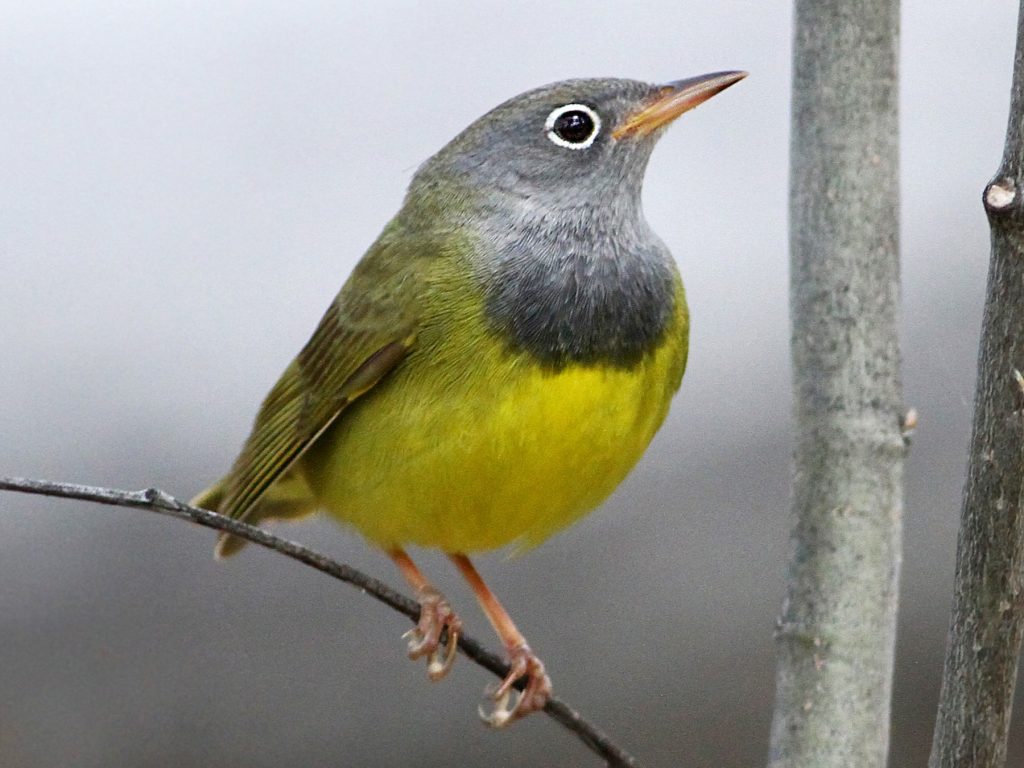
Connecticut Warblers pass through Kansas during migration, particularly from late April to May and again from late August to September. They are recorded on approximately 3% of checklists during spring migration and 2% of checklists during fall migration.
These warblers exhibit olive-brown plumage with a gray head and a yellow-green throat. They have a relatively long and slender bill.
Scientific name: Oporornis agilis
Length: 5.1-5.9 inches (13-15 cm)
Weight: 0.4-0.6 ounces (11-17 g)
Wingspan: 8.3-9.1 inches (21-23 cm)
Connecticut Warblers breed in boreal forests across Canada. During migration, they can be observed across the entire United States.
These warblers prefer habitats with dense undergrowth, such as wet thickets, marshes, and shrubby areas near water. They feed on insects, spiders, and small berries.
Connecticut Warbler Song:
Credit: Paul Marvin, XC438951. Accessible at www.xeno-canto.org/438951.
Nests of Connecticut Warblers are built on or near the ground, often hidden in dense vegetation or shrubs. They are constructed from leaves, grass, and bark, lined with fine grasses, feathers, and hair. They lay approximately four to six eggs, requiring about two weeks for hatching.
23. Hooded Warbler
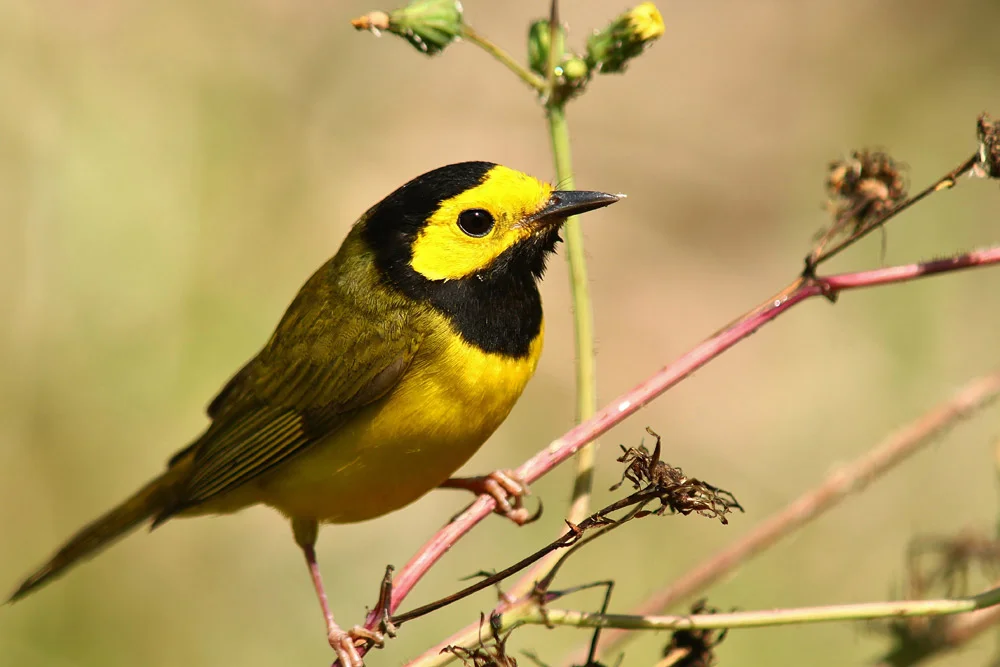
Hooded Warblers pass through Kansas during migration, particularly from late April to May and again from late August to September. They are recorded on approximately 6% of checklists during spring migration and 4% of checklists during fall migration.
These warblers exhibit bright yellow plumage with a black hood and bib. Males possess a black face, while females display a gray face.
Scientific name: Setophaga citrina
Length: 4.3-4.7 inches (11-12 cm)
Weight: 0.3-0.4 ounces (8-11 g)
Wingspan: 7.1-7.5 inches (18-19 cm)
Hooded Warblers breed in eastern US states and parts of Canada. During migration, they can be observed across the entire United States.
These warblers prefer habitats with dense undergrowth, such as forests, thickets, and woodland edges. They feed on insects, spiders, and occasionally small berries.
Hooded Warbler Song:
Credit: Andrew Spencer, XC479190. Accessible at www.xeno-canto.org/479190.
Nests of Hooded Warblers are built on or near the ground, often hidden in dense vegetation or shrubs. They are constructed from leaves, grass, and bark, lined with fine grasses, feathers, and hair. They lay approximately three to five eggs, requiring about two weeks for hatching.
24. Kentucky Warbler
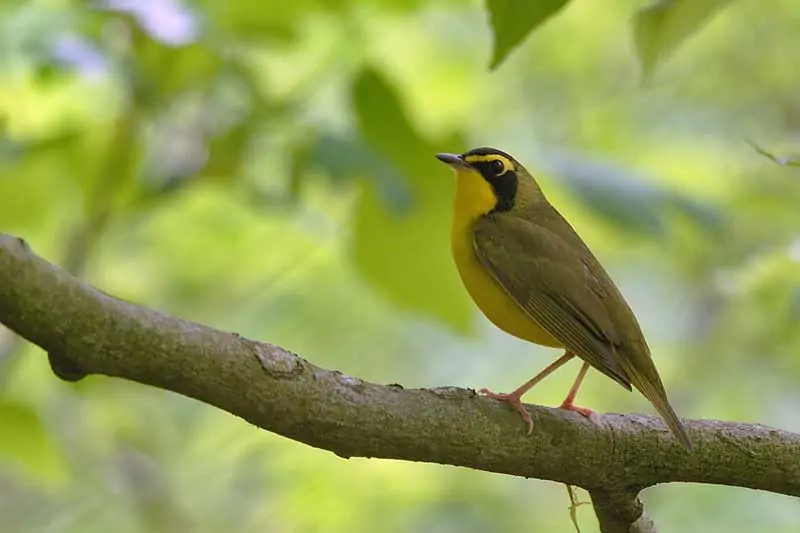
Kentucky Warblers pass through Kansas during migration, particularly from late April to May and again from late August to September. They are recorded on approximately 4% of checklists during spring migration and 3% of checklists during fall migration.
These warblers exhibit yellow plumage with a black mask and bib. They have a relatively short tail and a rounded body shape.
Scientific name: Geothlypis formosa
Length: 4.7-5.5 inches (12-14 cm)
Weight: 0.4-0.5 ounces (12-15 g)
Wingspan: 7.5-8.3 inches (19-21 cm)
Kentucky Warblers breed in eastern US states and parts of the southeastern US. During migration, they can be observed across the eastern and central United States.
These warblers prefer habitats with dense undergrowth, such as forests, thickets, and woodland edges. They feed on insects, spiders, and small invertebrates.
Kentucky Warbler Song:
Credit: Frank Lambert, XC660532. Accessible at www.xeno-canto.org/660532.
Nests of Kentucky Warblers are built on or near the ground, often hidden in dense vegetation or shrubs. They are constructed from leaves, grass, and bark, lined with fine grasses, feathers, and hair. They lay approximately three to five eggs, requiring about two weeks for hatching.
25. Prairie Warbler
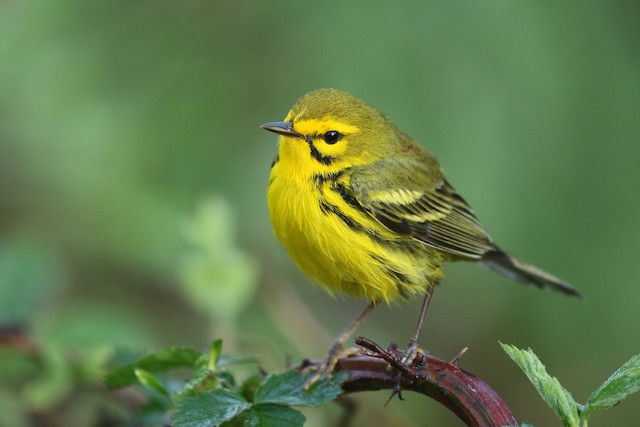
Prairie Warblers pass through Kansas during migration, particularly from late April to May and again from late August to September. They are recorded on approximately 5% of checklists during spring migration and 4% of checklists during fall migration.
These warblers exhibit yellow plumage with black streaks on the sides and a black face mask. Males possess a chestnut patch on their upper breast, while females display a paler coloration.
Scientific name: Setophaga discolor
Length: 4.3-4.7 inches (11-12 cm)
Weight: 0.3-0.4 ounces (8-11 g)
Wingspan: 7.1-7.5 inches (18-19 cm)
Prairie Warblers breed in the eastern and southeastern United States. During migration, they can be observed across the eastern and central United States.
These warblers prefer open habitats, including shrubby areas, regenerating clearings, and grasslands. They feed on insects, spiders, and occasionally small fruits.
Prairie Warbler Song:
Credit: Andrew Spencer, XC469738. Accessible at www.xeno-canto.org/469738.
Nests of Prairie Warblers are built on or near the ground, often hidden in dense vegetation or shrubs. They are constructed from grass, bark, and leaves, lined with fine grasses, feathers, and hair. They lay approximately three to five eggs, requiring about two weeks for hatching.
26. Bay-breasted Warbler

Bay-breasted Warblers pass through Kansas during migration, particularly from late April to May and again from late August to September. They are recorded on approximately 6% of checklists during spring migration and 4% of checklists during fall migration.
These warblers exhibit pinkish-brown plumage with a black-streaked crown and flanks. Males possess a
chestnut-colored patch on their sides, while females display a paler coloration.
Scientific name: Setophaga castanea
Length: 4.7-5.1 inches (12-13 cm)
Weight: 0.4-0.5 ounces (12-14 g)
Wingspan: 7.5-8.3 inches (19-21 cm)
Bay-breasted Warblers breed in northern North America, including Canada and Alaska. During migration, they can be observed across the entire United States.
These warblers prefer coniferous and mixed forests, particularly at higher elevations. They feed on insects, spiders, and occasionally small fruits.
Bay-breasted Warbler Song:
Credit: Andrew Spencer, XC685808. Accessible at www.xeno-canto.org/685808.
Nests of Bay-breasted Warblers are built on or near the ground, often hidden in dense vegetation or shrubs. They are constructed from bark, twigs, and grass, lined with fine grasses, feathers, and hair. They lay approximately three to five eggs, requiring about two weeks for hatching.
27. Canada Warbler
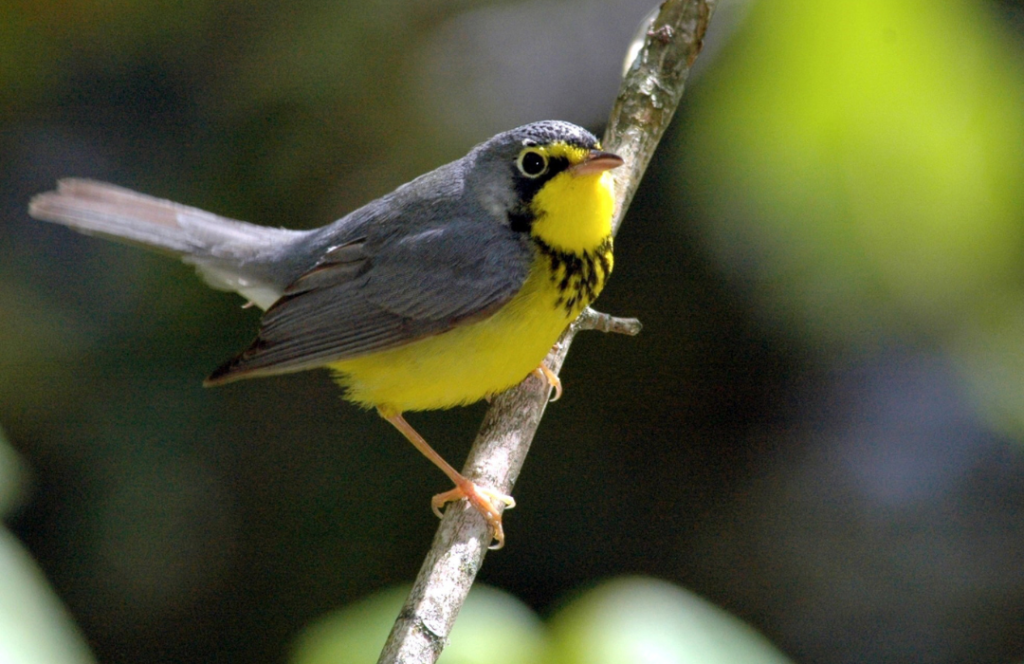
Canada Warblers pass through Kansas during migration, particularly from late April to May and again from late August to September. They are recorded on approximately 4% of checklists during spring migration and 3% of checklists during fall migration.
These warblers exhibit grayish-blue plumage with a black necklace-like band across the yellow breast. They have a relatively short tail and a rounded body shape.
Scientific name: Cardellina canadensis
Length: 4.7-5.1 inches (12-13 cm)
Weight: 0.3-0.4 ounces (9-11 g)
Wingspan: 7.5-7.9 inches (19-20 cm)
Canada Warblers breed in boreal forests across Canada and Alaska. During migration, they can be observed across the entire United States.
These warblers prefer habitats with dense undergrowth, such as young forests, shrubby areas, and regenerating clearings. They feed on insects, spiders, and small fruits.
Canada Warbler Song:
Credit: Andrew Spencer, XC575727. Accessible at www.xeno-canto.org/575727.
Nests of Canada Warblers are built on or near the ground, often hidden in dense vegetation or shrubs. They are constructed from grass, bark, and leaves, lined with fine grasses, feathers, and hair. They lay approximately four to five eggs, requiring about two weeks for hatching.
28. Yellow-breasted Chat

Yellow-breasted Chats pass through Kansas during migration, particularly from late April to May and again from late August to September. They are recorded on approximately 8% of checklists during spring migration and 6% of checklists during fall migration.
Yellow-breasted Chats are unique among warblers in their appearance and behavior. They exhibit yellowish-green plumage with a bold white spectacles pattern and a yellow breast. They have a long tail and a relatively large body.
Scientific name: Icteria virens
Length: 6.7-7.5 inches (17-19 cm)
Weight: 0.8-1.1 ounces (23-31 g)
Wingspan: 8.7-9.8 inches (22-25 cm)
Yellow-breasted Chats breed in shrubby habitats across the eastern and central United States. During migration, they can be observed across the entire United States.
These birds prefer thickets, brushy areas, and shrubby edges of wetlands. They feed on insects, spiders, and occasionally fruits.
Yellow-breasted Chat Song:
Credit: Andrew
Spencer, XC492987. Accessible at www.xeno-canto.org/492987.
Nests of Yellow-breasted Chats are built in dense vegetation, often near the ground. They are constructed from leaves, grass, and bark, lined with finer materials such as plant fibers and hair. They lay approximately three to five eggs, requiring about two weeks for hatching.
29. Prothonotary Warbler
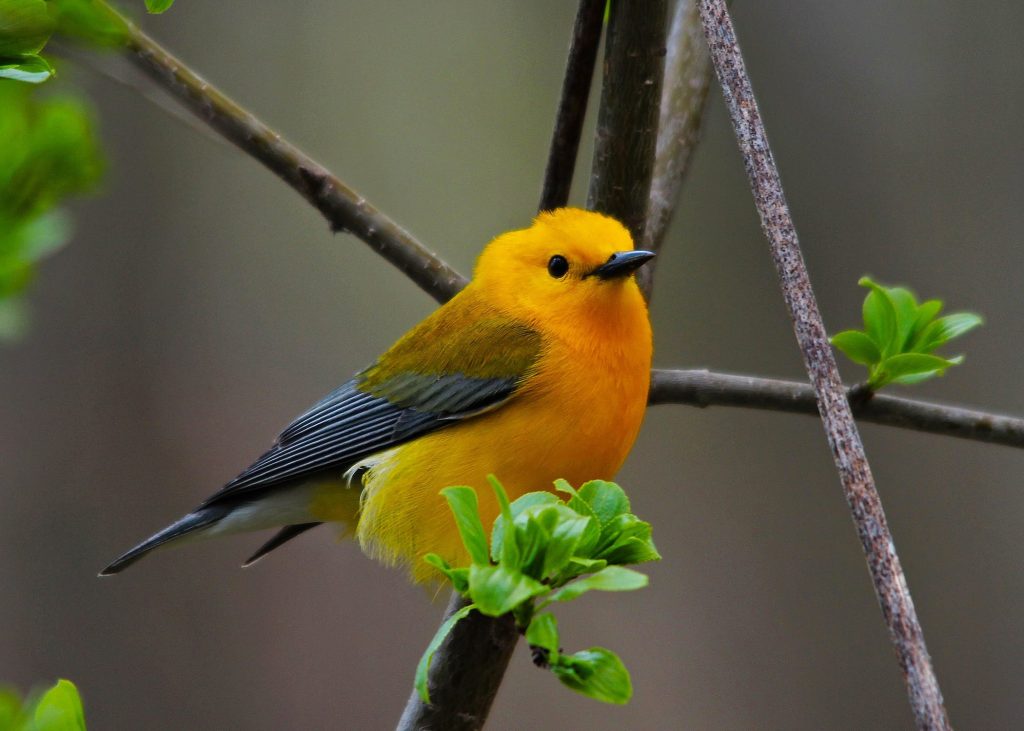
Prothonotary Warblers pass through Kansas during migration, particularly from late April to May and again from late August to September. They are recorded on approximately 6% of checklists during spring migration and 4% of checklists during fall migration.
These warblers exhibit bright yellow plumage with a gray-blue back and wings. Males possess a bold black eye-line, while females display a paler coloration.
Scientific name: Protonotaria citrea
Length: 4.3-5.1 inches (11-13 cm)
Weight: 0.4-0.5 ounces (11-14 g)
Wingspan: 7.5-8.3 inches (19-21 cm)
Prothonotary Warblers breed in bottomland forests and swamps across the southeastern United States. During migration, they can be observed across the eastern and central United States.
These warblers prefer habitats near water bodies, such as swamps, marshes, and riparian areas. They feed on insects, spiders, and occasionally small crustaceans.
Prothonotary Warbler Song:
Credit: Paul Marvin, XC618418. Accessible at www.xeno-canto.org/618418.
Nests of Prothonotary Warblers are built in tree cavities, natural tree holes, or artificial nest boxes. They are constructed from grass, bark, and plant fibers, lined with finer materials such as feathers and hair. They lay approximately three to seven eggs, requiring about two weeks for hatching.
30. Swainson’s Warbler
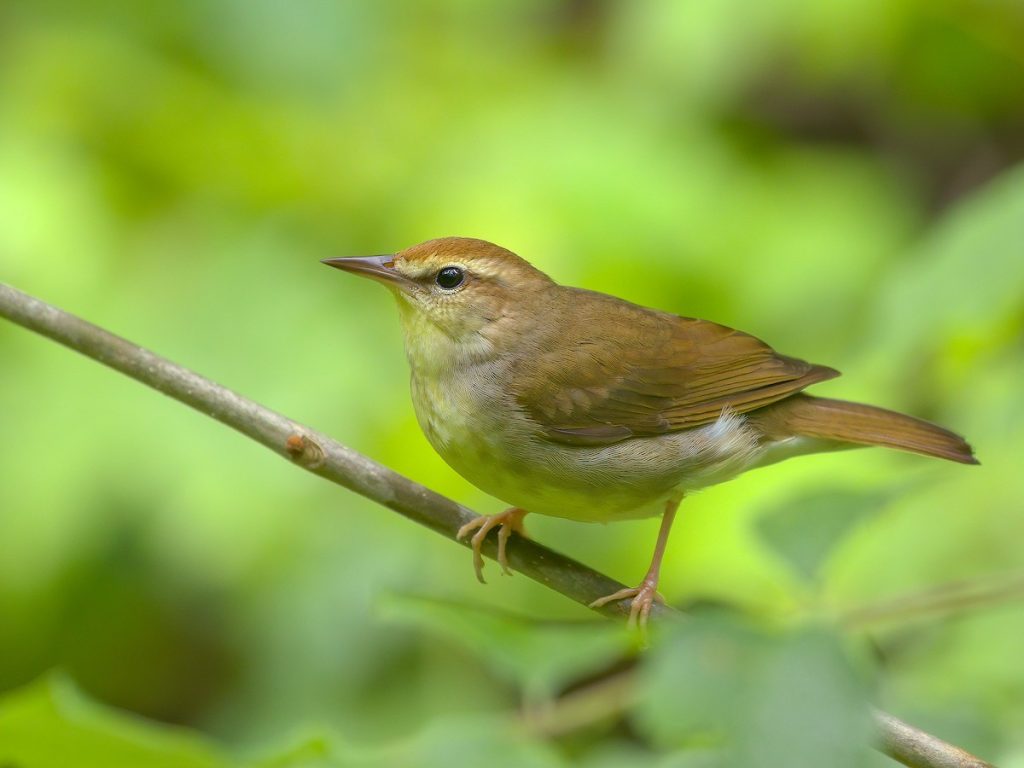
Swainson’s Warblers pass through Kansas during migration, particularly from late April to May and again from late August to September. They are recorded on approximately 3% of checklists during spring migration and 2% of checklists during fall migration.
These warblers exhibit plain brown plumage with a rusty crown and a creamy-white throat. They have a relatively long bill and a habit of skulking in dense vegetation.
Scientific name: Limnothlypis swainsonii
Length: 5.5-6.3 inches (14-16 cm)
Weight: 0.5-0.6 ounces (14-17 g)
Wingspan: 8.7-9.4 inches (22-24 cm)
Swainson’s Warblers breed in bottomland forests and swamps across the southeastern United States. During migration, they can be observed across the eastern and central United States.
These warblers prefer habitats with dense undergrowth, such as wet thickets, marshes, and shrubby areas near water. They feed on insects, spiders, and small invertebrates.
Swainson’s Warbler Song:
Credit: Jacob Wijpkema, XC581359. Accessible at www.xeno-canto.org/581359.
Nests of Swainson’s Warblers are built on or near the ground, often hidden in dense vegetation or shrubs. They are constructed from leaves, grass, and bark, lined with fine grasses, feathers, and hair. They lay approximately three to five eggs, requiring about two weeks for hatching.
31. Cerulean Warbler
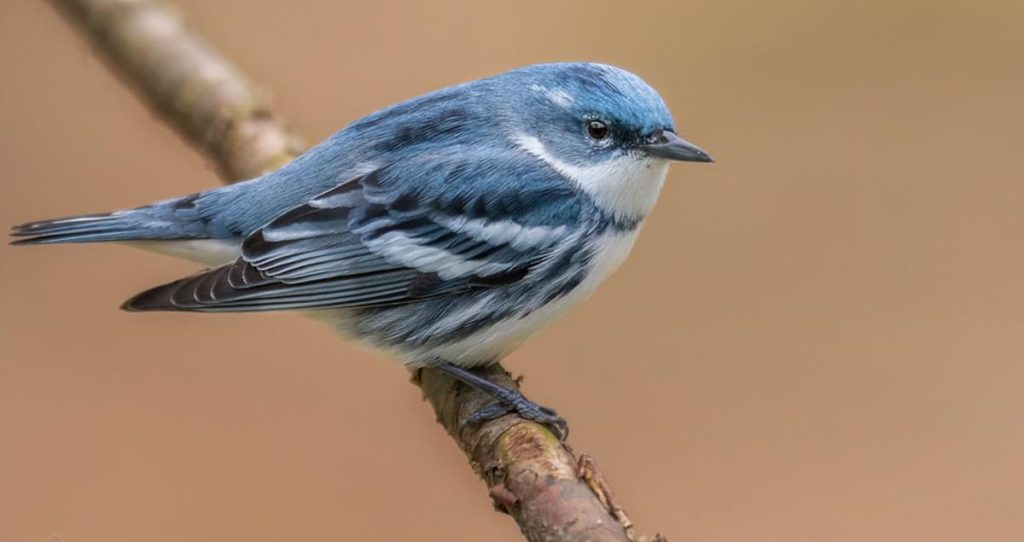
Cerulean Warblers pass through Kansas during migration, particularly from late April to May and again from late August to September. They are recorded on approximately 5% of checklists during spring migration and 4% of checklists during fall migration.
These warblers exhibit bright blue plumage on the upperparts and a white belly. Males possess a black necklace-like band across the blue upper breast, while females display a paler coloration.
Scientific name: Setophaga cerulea
Length: 4.3-5.1 inches (11-13 cm)
Weight: 0.4-0.5 ounces (11-14 g)
Wingspan: 7.5-8.3 inches (19-21 cm)
Cerulean Warblers breed in mature deciduous forests across the eastern United States and parts of Canada. During migration, they can be observed across the eastern and central United States.
These warblers prefer tall, mature forests with a closed canopy. They feed on insects, spiders, and occasionally small fruits.
Cerulean Warbler Song:
Credit: Andrew Spencer, XC515648. Accessible at www.xeno-canto.org/515648.
Nests of Cerulean Warblers are built high in the canopy of deciduous trees. They are constructed from twigs, bark, grass, and plant fibers, lined with finer materials such as feathers and hair. They lay approximately three to five eggs, requiring about two weeks for hatching.
32. Black-throated Blue Warbler

Black-throated Blue Warblers pass through Kansas during migration, particularly from late April to May and again from late August to September. They are recorded on approximately 7% of checklists during spring migration and 5% of checklists during fall migration.
These warblers exhibit blackish-blue plumage on the upperparts and a white belly. Males possess a black throat patch, while females display a paler coloration with a hint of blue.
Scientific name: Setophaga caerulescens
Length: 4.7-5.1 inches (12-13 cm)
Weight: 0.4-0.5 ounces (11-14 g)
Wingspan: 7.5-8.3 inches (19-21 cm)
Black-throated Blue Warblers breed in mature deciduous and mixed forests across the northeastern United States and Canada. During migration, they can be observed across the eastern and central United States.
These warblers prefer habitats with dense undergrowth, such as forests, thickets, and woodland edges. They feed on insects, spiders, and occasionally small fruits.
Black-throated Blue Warbler Song:
Credit: Andrew Spencer, XC533337. Accessible at www.xeno-canto.org/533337.
Nests of Black-throated Blue Warblers are built low in shrubs or on the ground, often hidden in dense vegetation. They are constructed from leaves, bark, and plant fibers, lined with finer materials such as feathers and hair. They lay approximately three to five eggs, requiring about two weeks for hatching.
33. Townsend’s Warbler
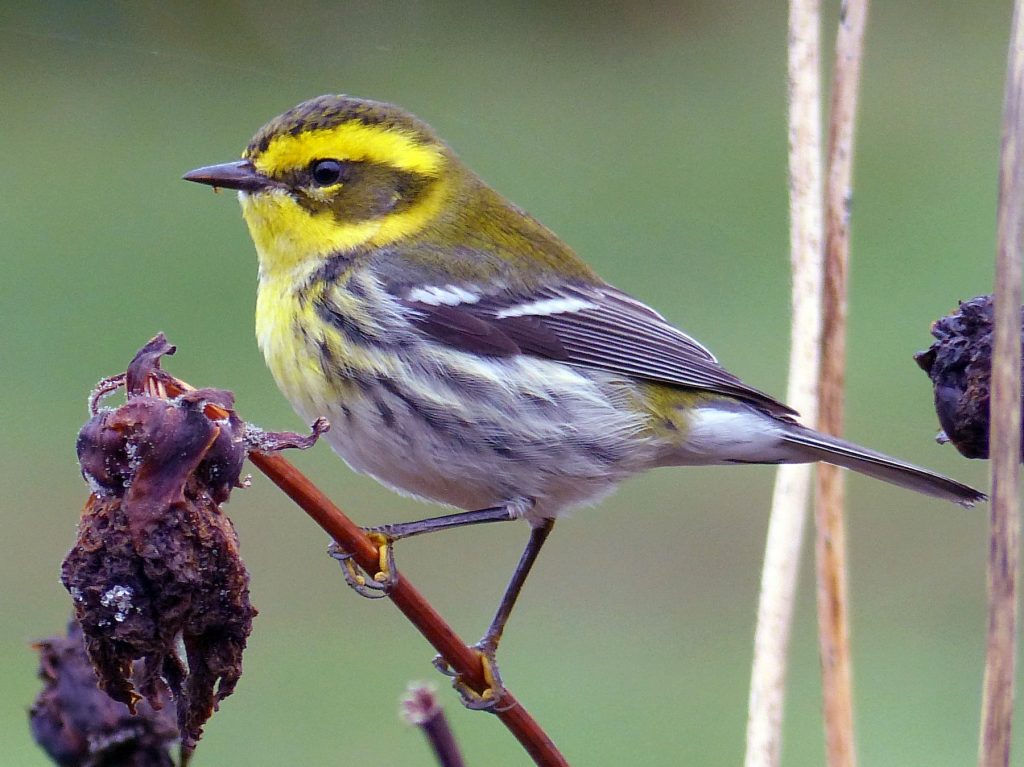
Townsend’s Warblers pass through Kansas during migration, particularly from late April to May and again from late August to September. They are recorded on approximately 4% of checklists during spring migration and 3% of checklists during fall migration.
These warblers exhibit yellow plumage with black streaks on the sides and a black cap. Males possess a yellow face patch, while females display a paler coloration.
Scientific name: Setophaga townsendi
Length: 4.7-5.5 inches (12-14 cm)
Weight: 0.3-0.4 ounces (9-11 g)
Wingspan: 7.5-8.7 inches (19-22 cm)
Townsend’s Warblers breed in coniferous and mixed forests across western North America, including parts of Canada. During migration, they can be observed across the western and central United States.
These warblers prefer habitats with coniferous trees, such as forests, woodlands, and conifer groves. They feed on insects, spiders, and occasionally small fruits.
Townsend’s Warbler Song:
Credit: Andrew Spencer, XC503868. Accessible at www.xeno-canto.org/503868.
Nests of Townsend’s Warblers are built in coniferous trees, often high above the ground. They are constructed from twigs, grass, bark, and plant fibers, lined with finer materials such as feathers and hair. They lay approximately three to six eggs, requiring about two weeks for hatching.
34. Black-throated Gray Warbler
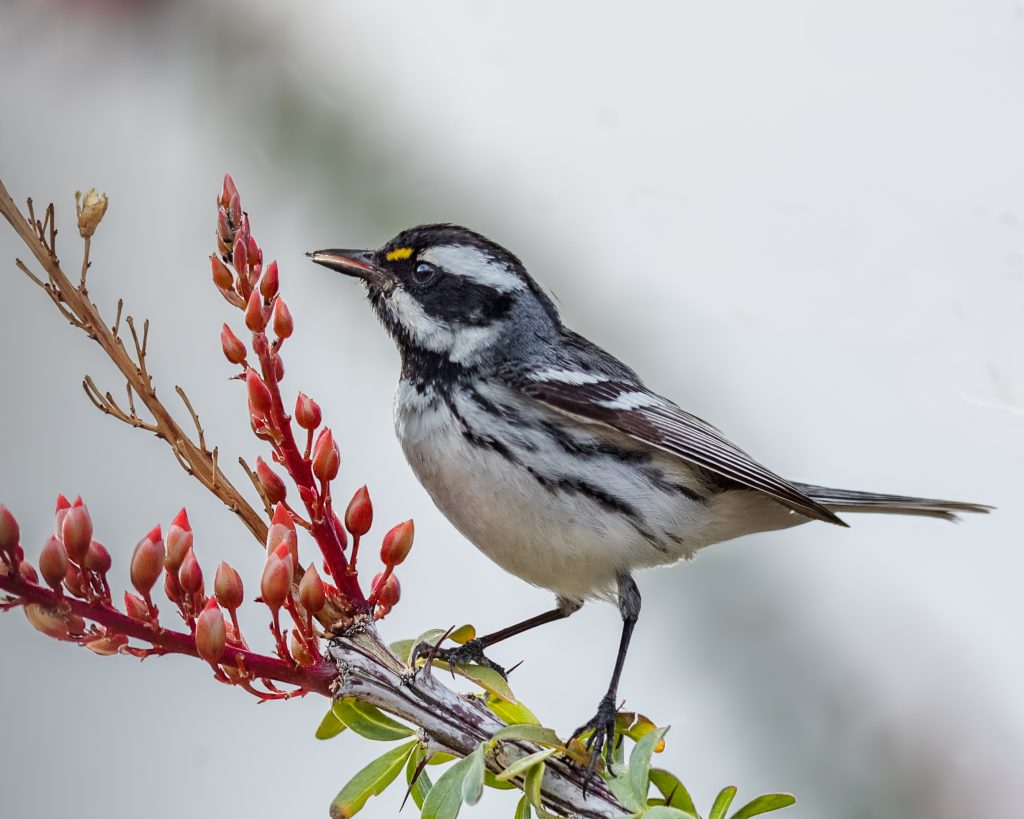
Black-throated Gray Warblers pass through Kansas during migration, particularly from late April to May and again from late August to September. They are recorded on approximately 3% of checklists during spring migration and 2% of checklists during fall migration.
These warblers exhibit gray plumage with black streaks on the sides and a black throat patch. Males possess a white face patch, while females display a paler coloration.
Scientific name: Setophaga nigrescens
Length: 4.3-4.7 inches (11-12 cm)
Weight: 0.3-0.4 ounces (8-11 g)
Wingspan: 7.1-7.9 inches (18-20 cm)
Black-throated Gray Warblers breed in coniferous and mixed forests across western North America, including parts of Canada. During migration, they can be observed across the western and central United States.
These warblers prefer habitats with coniferous trees, such as forests, woodlands, and conifer groves. They feed on insects, spiders, and occasionally small fruits.
Black-throated Gray Warbler Song:
Credit: Andrew Spencer, XC516285. Accessible at www.xeno-canto.org/516285.
Nests of Black-throated Gray Warblers are built in coniferous trees, often high above the ground. They are constructed from twigs, grass, bark, and plant fibers, lined with finer materials such as feathers and hair. They lay approximately three to five eggs, requiring about two weeks for hatching.
35. Virginia’s Warbler
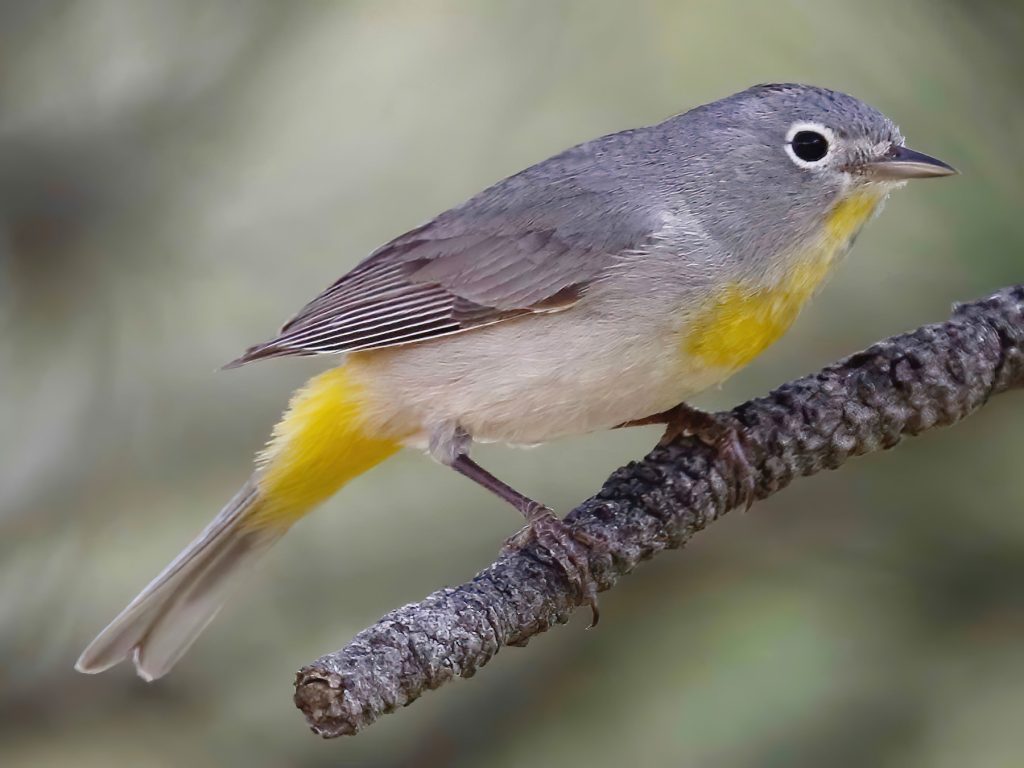
Virginia’s Warblers pass through Kansas during migration, particularly from late April to May and again from late August to September. They are recorded on approximately 3% of checklists during spring migration and 2% of checklists during fall migration.
These warblers exhibit gray plumage with a yellow breast and a gray cap. They have a relatively short tail and a rounded body shape.
Scientific name: Oreothlypis virginiae
Length: 4.3-4.7 inches (11-12 cm)
Weight: 0.3-0.4 ounces (8-11 g)
Wingspan: 7.1-7.9 inches (18-20 cm)
Virginia’s Warblers breed in mountainous areas of western North America, including parts of the United States and Mexico. During migration, they can be observed across the western and central United States.
These warblers prefer habitats with mixed shrubs, such as woodlands, riparian areas, and brushy slopes. They feed on insects, spiders, and occasionally small fruits.
Virginia’s Warbler Song:
Credit:
Nick Kiehl, XC595202. Accessible at www.xeno-canto.org/595202.
Nests of Virginia’s Warblers are built in shrubs or low vegetation, often hidden in dense vegetation. They are constructed from grass, bark, and plant fibers, lined with finer materials such as feathers and hair. They lay approximately three to five eggs, requiring about two weeks for hatching.
36. MacGillivray’s Warbler
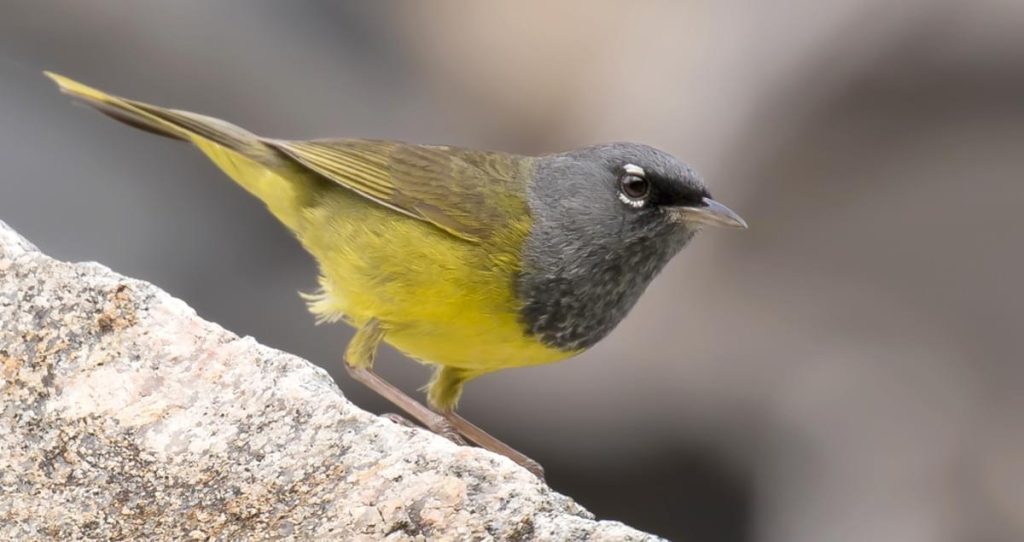
MacGillivray’s Warblers pass through Kansas during migration, particularly from late April to May and again from late August to September. They are recorded on approximately 4% of checklists during spring migration and 3% of checklists during fall migration.
These warblers exhibit gray plumage with a yellow breast and a gray cap. Males possess a black patch through the eye, while females display a paler coloration.
Scientific name: Geothlypis tolmiei
Length: 4.7-5.5 inches (12-14 cm)
Weight: 0.3-0.4 ounces (9-11 g)
Wingspan: 7.5-8.7 inches (19-22 cm)
MacGillivray’s Warblers breed in shrubby areas and coniferous forests across western North America, including parts of Canada. During migration, they can be observed across the western and central United States.
These warblers prefer habitats with dense shrubs, such as brushy areas, streamside thickets, and forest edges. They feed on insects, spiders, and occasionally small fruits.
MacGillivray’s Warbler Song:
Credit: Andrew Spencer, XC517164. Accessible at www.xeno-canto.org/517164.
Nests of MacGillivray’s Warblers are built on or near the ground, often hidden in dense vegetation or shrubs. They are constructed from grass, bark, and plant fibers, lined with finer materials such as feathers and hair. They lay approximately three to five eggs, requiring about two weeks for hatching.
37. Mourning Warbler
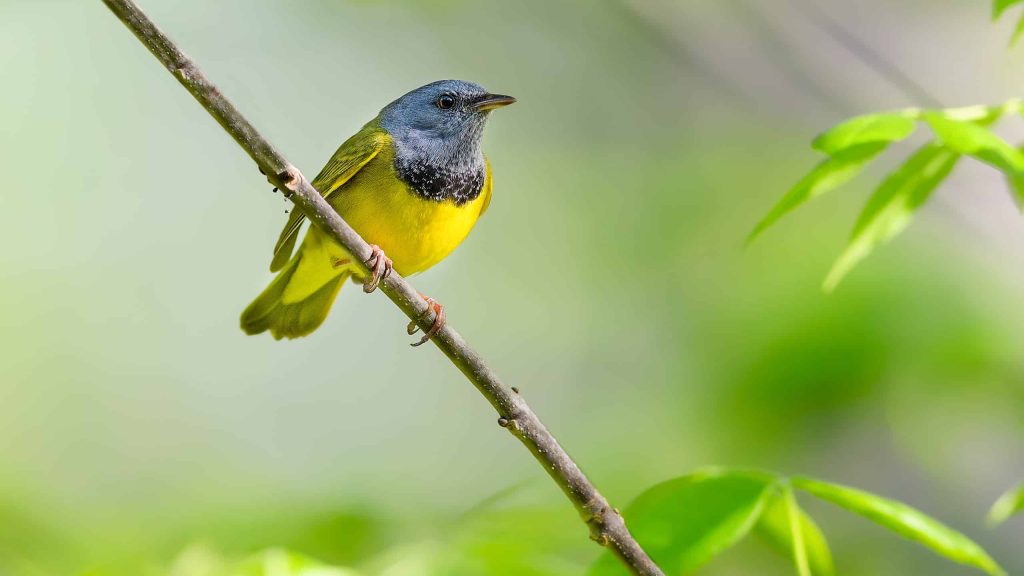
Mourning Warblers pass through Kansas during migration, particularly from late April to May and again from late August to September. They are recorded on approximately 4% of checklists during spring migration and 3% of checklists during fall migration.
These warblers exhibit olive-green plumage with a yellow belly and a gray cap. Males possess a black necklace-like band across the yellow breast, while females display a paler coloration.
Scientific name: Geothlypis philadelphia
Length: 4.7-5.1 inches (12-13 cm)
Weight: 0.3-0.4 ounces (9-11 g)
Wingspan: 7.5-8.3 inches (19-21 cm)
Mourning Warblers breed in the boreal forests of North America, including parts of Canada and the northeastern United States. During migration, they can be observed across the eastern and central United States.
These warblers prefer habitats with dense undergrowth, such as shrubby areas, wet thickets, and forest edges. They feed on insects, spiders, and occasionally small fruits.
Mourning Warbler Song:
Credit: Andrew Spencer, XC501868. Accessible at www.xeno-canto.org/501868.
Nests of Mourning Warblers are built close to the ground, often hidden in dense vegetation or shrubs. They are constructed from grass, bark, and plant fibers, lined with finer materials such as feathers and hair. They lay approximately three to five eggs, requiring about two weeks for hatching.
38. Connecticut Warbler

Connecticut Warblers pass through Kansas during migration, particularly from
late April to May and again from late August to September. They are recorded on approximately 3% of checklists during spring migration and 2% of checklists during fall migration.
These warblers exhibit olive-brown plumage with a yellow belly and a gray cap. They have a relatively long tail and a rounded body shape.
Scientific name: Oporornis agilis
Length: 5.9-6.3 inches (15-16 cm)
Weight: 0.6-0.7 ounces (17-20 g)
Wingspan: 8.7-9.8 inches (22-25 cm)
Connecticut Warblers breed in the boreal forests of North America, primarily in Canada. During migration, they can be observed across the eastern and central United States.
These warblers prefer habitats with dense undergrowth, such as shrubby areas, wet thickets, and forest edges. They feed on insects, spiders, and occasionally small fruits.
Connecticut Warbler Song:
Credit: Andrew Spencer, XC528636. Accessible at www.xeno-canto.org/528636.
Nests of Connecticut Warblers are built close to the ground, often hidden in dense vegetation or shrubs. They are constructed from grass, bark, and plant fibers, lined with finer materials such as feathers and hair. They lay approximately three to five eggs, requiring about two weeks for hatching.
39. Wilson’s Warbler
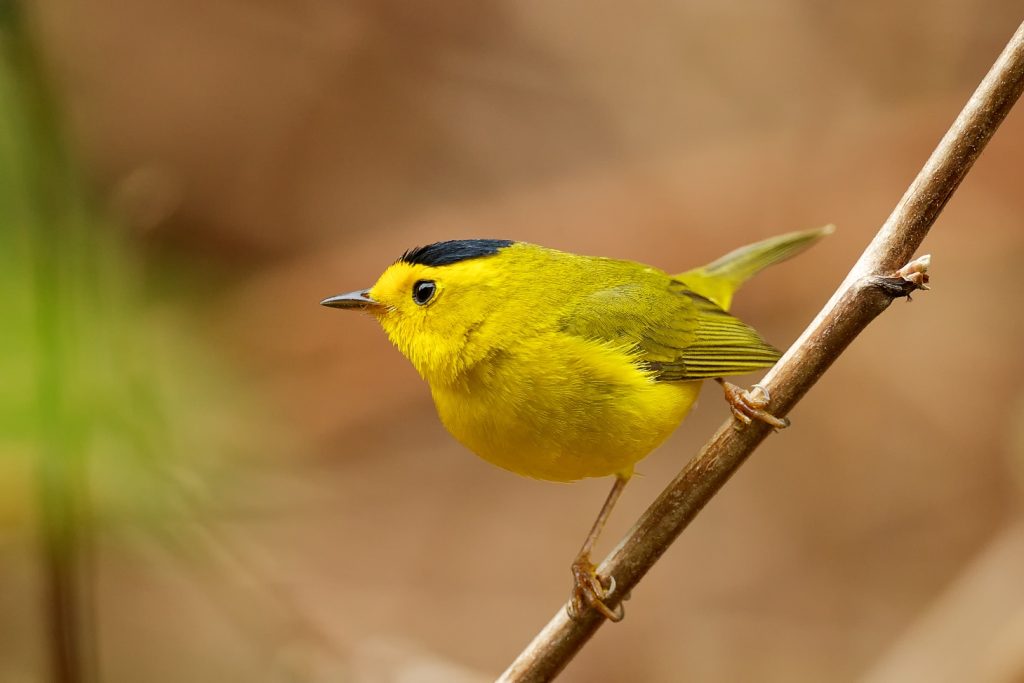
Wilson’s Warblers pass through Kansas during migration, particularly from late April to May and again from late August to September. They are recorded on approximately 6% of checklists during spring migration and 5% of checklists during fall migration.
These warblers exhibit bright yellow plumage with a black cap. Males possess a black necklace-like band across the yellow breast, while females display a paler coloration.
Scientific name: Cardellina pusilla
Length: 4.7-5.1 inches (12-13 cm)
Weight: 0.3-0.4 ounces (9-11 g)
Wingspan: 7.5-8.3 inches (19-21 cm)
Wilson’s Warblers breed in moist, shrubby areas across western North America, including parts of Canada and the western United States. During migration, they can be observed across the western and central United States.
These warblers prefer habitats with dense undergrowth, such as shrubby areas, wet thickets, and streamside vegetation. They feed on insects, spiders, and occasionally small fruits.
Wilson’s Warbler Song:
Credit: Andrew Spencer, XC515497. Accessible at www.xeno-canto.org/515497.
Nests of Wilson’s Warblers are built close to the ground, often hidden in dense vegetation or shrubs. They are constructed from grass, bark, and plant fibers, lined with finer materials such as feathers and hair. They lay approximately three to five eggs, requiring about two weeks for hatching.
These 39 species of warblers showcase the incredible diversity and beauty of these migratory songbirds that grace Kansas during different seasons. From their vibrant plumage to their melodic songs, warblers captivate birdwatchers and bring joy to nature enthusiasts.
The Frequency of Warbler Sightings in Kansas during Summer and Winter
Discovering the occurrence of warblers in your state can be easily accomplished through checklists, which serve as invaluable references. These comprehensive lists reveal the prevalence of various warbler species during summer and winter in Kansas, based on their frequency of appearance on ebird checklists.
Warblers commonly sighted in Kansas during summer:
– The Yellow Warbler holds the highest record at 19.4%.
– Following closely is the Common Yellowthroat, accounting for 13.8%.
– The Northern Parula claims the third spot with 11.8%.
– The Yellow-rumped Warbler follows suit at 9.1%.
– Progressing down the list, we find the Nashville Warbler with 7.0%.
– With a 6.0% representation, the Orange-crowned Warbler ranks next.
– The Tennessee Warbler stands at 5.7%.
– The American Redstart and Black-and-white Warbler share the spotlight at 5.6% and 4.5%, respectively.
– The Louisiana Waterthrush follows with 4.0%.
– The Prothonotary Warbler and Blackpoll Warbler are tied at 3.2%.
– The Wilson’s Warbler claims 3.1% of the recorded sightings.
– Not far behind is the Kentucky Warbler with 3.0%.
– The Yellow-breasted Chat boasts 2.2% representation.
– The Chestnut-sided Warbler secures 1.8%.
– The Magnolia Warbler makes its mark at 1.6%.
– The Northern Waterthrush follows closely at 1.5%.
– The Ovenbird claims 1.4% of the sightings.
– With 1.2% representation, the Yellow-throated Warbler adds to the diversity.
– The Mourning Warbler emerges at 1.1%.
– The Blackburnian Warbler boasts 0.9%.
– The Palm Warbler and Golden-winged Warbler share 0.8% and 0.7%, respectively.
– The Black-throated Green Warbler accounts for 0.6%.
– The Canada Warbler represents 0.5%.
– The Bay-breasted Warbler shows up at 0.2%.
– The Blue-winged Warbler, MacGillivray’s Warbler, Cape May Warbler, Hooded Warbler, Worm-eating Warbler, Prairie Warbler, Black-throated Blue Warbler, Cerulean Warbler, Pine Warbler, Townsend’s Warbler, Black-throated Gray Warbler, and Virginia’s Warbler all appear at a rate below 0.1%.
Warblers sighted in Kansas during winter:
– The Yellow-rumped Warbler holds the highest record at 10.4%.
– The Orange-crowned Warbler appears at a mere 0.2%.
– The Pine Warbler follows closely at 0.1%.
– The Common Yellowthroat, Palm Warbler, Northern Waterthrush, Cape May Warbler, Prairie Warbler, and Yellow-throated Warbler all emerge at a rate below 0.1%.
Attracting Warblers to Your Backyard
While warblers are not frequent visitors to backyard feeders like other songbirds, there are methods to entice these harmonious avian wonders to grace your yard:
– If your yard has ample space, providing trees will attract warblers.
– Embrace a less tidy approach and leave brush piles to foster habitats for insect friends.
– Avoid the use of pesticides or herbicides, ensuring an abundant insect population for the birds to feast upon.
– Offer a clean water source, enticing warblers with a refreshing drink.
– Consider providing mealworms, preferably live, although dried ones can be a suitable alternative.
– Bird feeders stocked with sunflower seeds, peanut hearts, and suet can entice warblers to pay a visit.
